California Documents
Quitclaim Deed
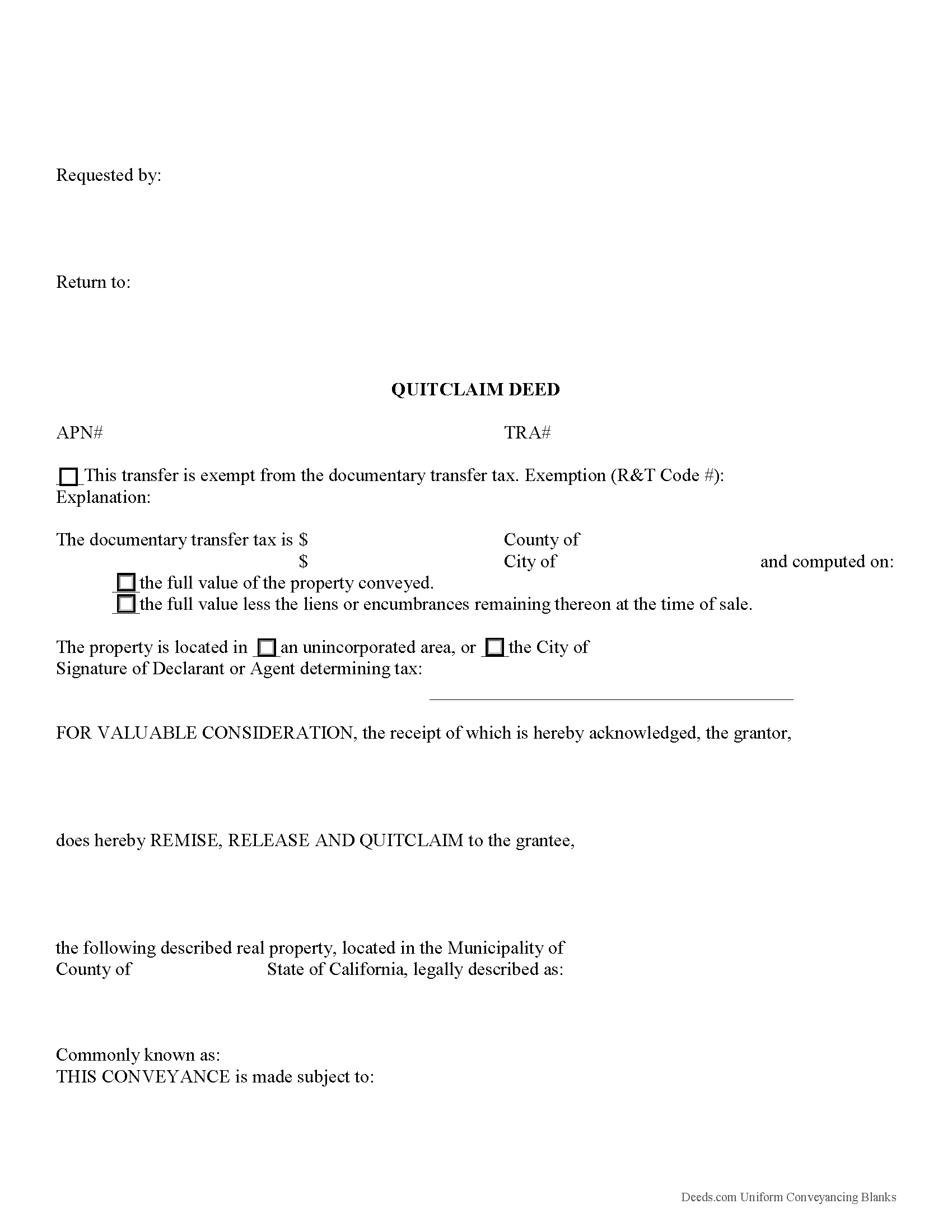
Quitclaim deeds in California are initially defined by Civ. Code, 1092, 1104-1107, 1113, and further in Gov. Code 27279-27297.7, 27320-27337.
Content:
Each document submitted for recording should have the title near the top of the first page (Gov. Code 27324). Include the name and address of the individual requesting recording as well as a name and return address for use after the quitclaim deed is recorded. Provide the name and address of the individual or entity to receive tax bills at the bottom of the first page. (Gov. Code 27321.5, 27361.6). In addition, every quit claim deed must contain the name and address of everyone with an ownership interest in the property. Be certain to present the names in exactly the same way they're found on the prior deed. If there are any unrecorded changes, provide the original and new names like this: Jane Doe, formerly known as Jane Smith. See Gov. Code 27288.1.
Any document which modifies, releases, or cancels the provisions of a previously recorded document shall state the recorder identification number or the book and page of the document being modified, released, or canceled. (Gov. Code 27361.6). Additionally, Gov. Code 27280... More Information about the California Quitclaim Deed
Gift Deed
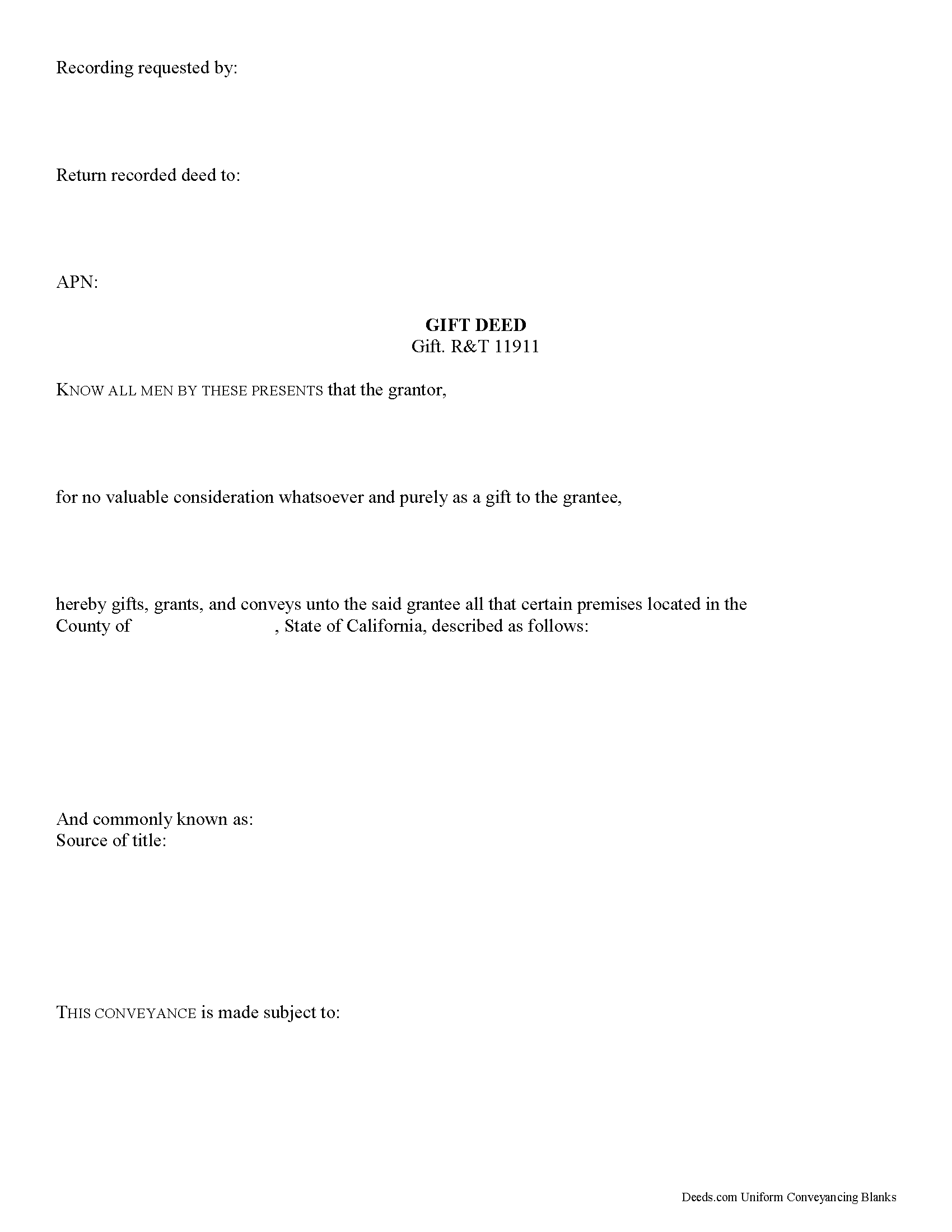
Gifts of Real Property in California
Gift deeds convey title to real property from one party to another with no exchange of consideration, monetary or otherwise. Often used to transfer property between family members or to gift property as a charitable act or donation, these conveyances occur during the grantor's lifetime. Gift deeds must contain language that explicitly states that no consideration is expected or required. Ambiguous language, or references to any type of consideration, can make the gift deed contestable in court.
A lawful gift deed includes the grantor's full name and marital status, as well as the grantee's full name, marital status, vesting, and mailing address. Vesting describes how the grantee holds title to the property. Generally, real property is owned in either sole ownership or in co-ownership. For California residential property, the primary methods for holding title in co-ownership are tenancy in common, joint tenancy, and community property (Cal. Civ. Code 682). An estate conveyed to two or more unmarried people is considered a tenancy in common, unless a joint tenancy is designated (Cal. Civ. Code 683). Spouses vest as community property, with... More Information about the California Gift Deed
Warranty Deed
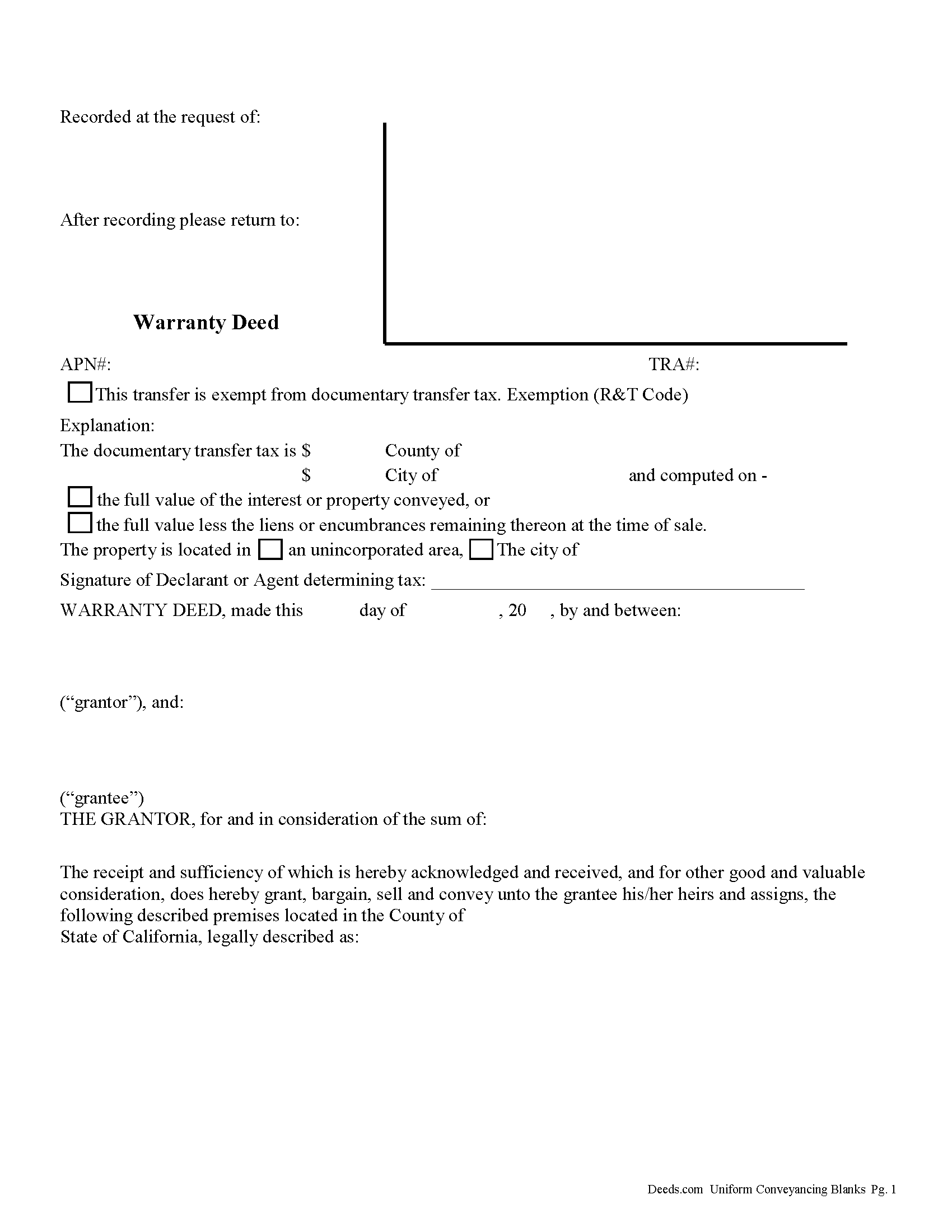
A transfer of real property in California is an act of the parties, or of the law, by which the title to real property is conveyed from one living person to another (CIV 1039). Transfers of real estate are conducted through the use of standard real estate deeds, such as warranty deeds, which are used often in this state for a conveyance of real property.
The use of the word "grant" in a conveyance by which any estate in fee simple or inheritance is to be passed implies the following covenants, and none other, on the part of the grantor for himself and his heirs to the grantee, his heirs, and assigns, unless they are restrained by specific terms in the deed: (1) That previous to the time of execution of the conveyance, the grantor has not conveyed the same estate, or any right, title, or interest therein to any person other than the grantee and (2) that the estate is, at the time of execution of the conveyance, free from any encumbrances done, made, or suffered by the grantor or by any person claiming under him (CIV 1113). Although the California Statutes do not address it, the grantor in a warranty deed will warrant and defend the title against the claims of all persons.
Th... More Information about the California Warranty Deed
Special Warranty Deed
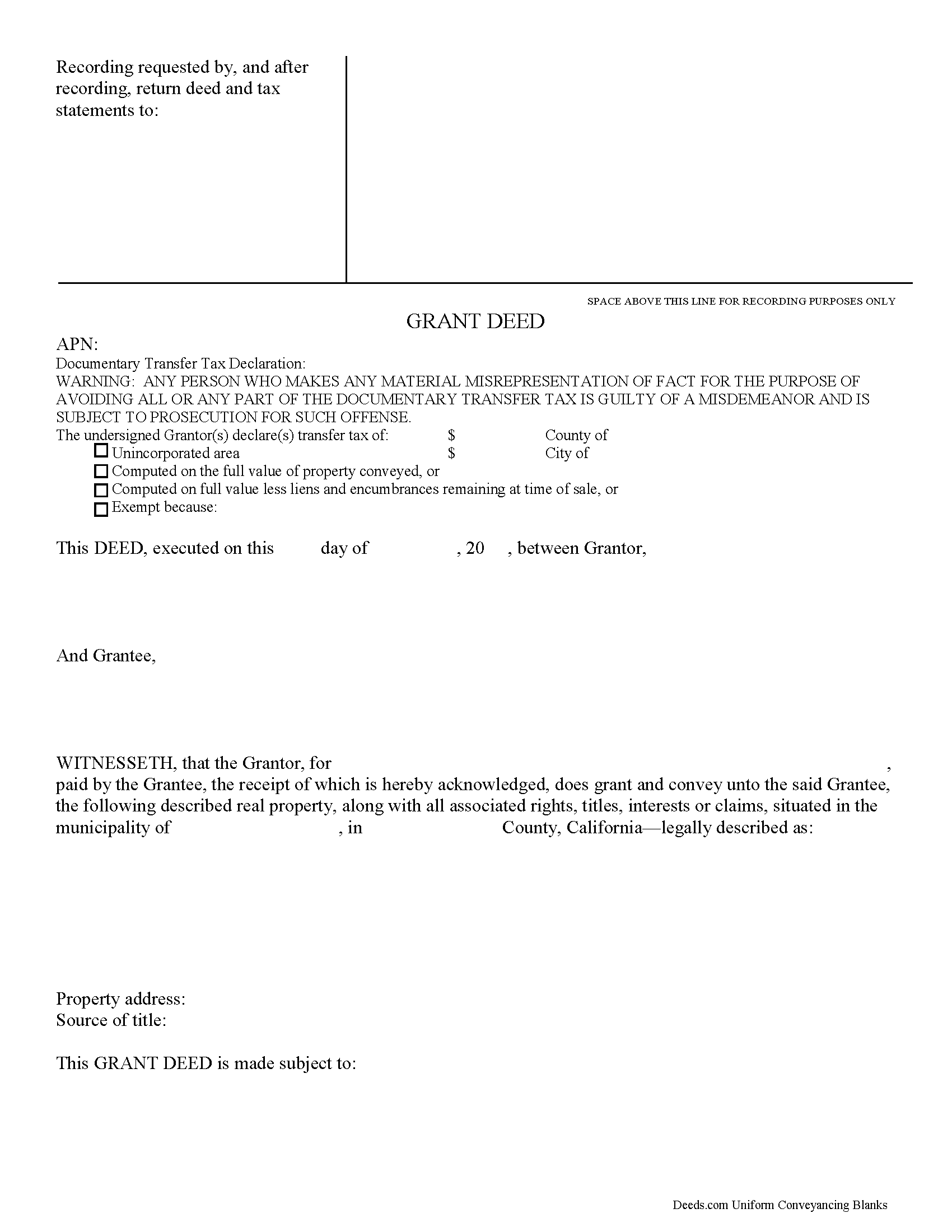
A Special Warranty Deed is similar to a General Warranty Deed however it only contains two basic warranties:
a. That the grantor received title.
b. That the property was not encumbered during the time the grantor held title, except as otherwise noted in the deed.
In a special Warranty Deeds the grantor may include additional warranties but they must be specifically stated in the deed.
(California Special Warranty Deed Package includes form, guidelines, and completed example)... More Information about the California Special Warranty Deed
Grant Deed
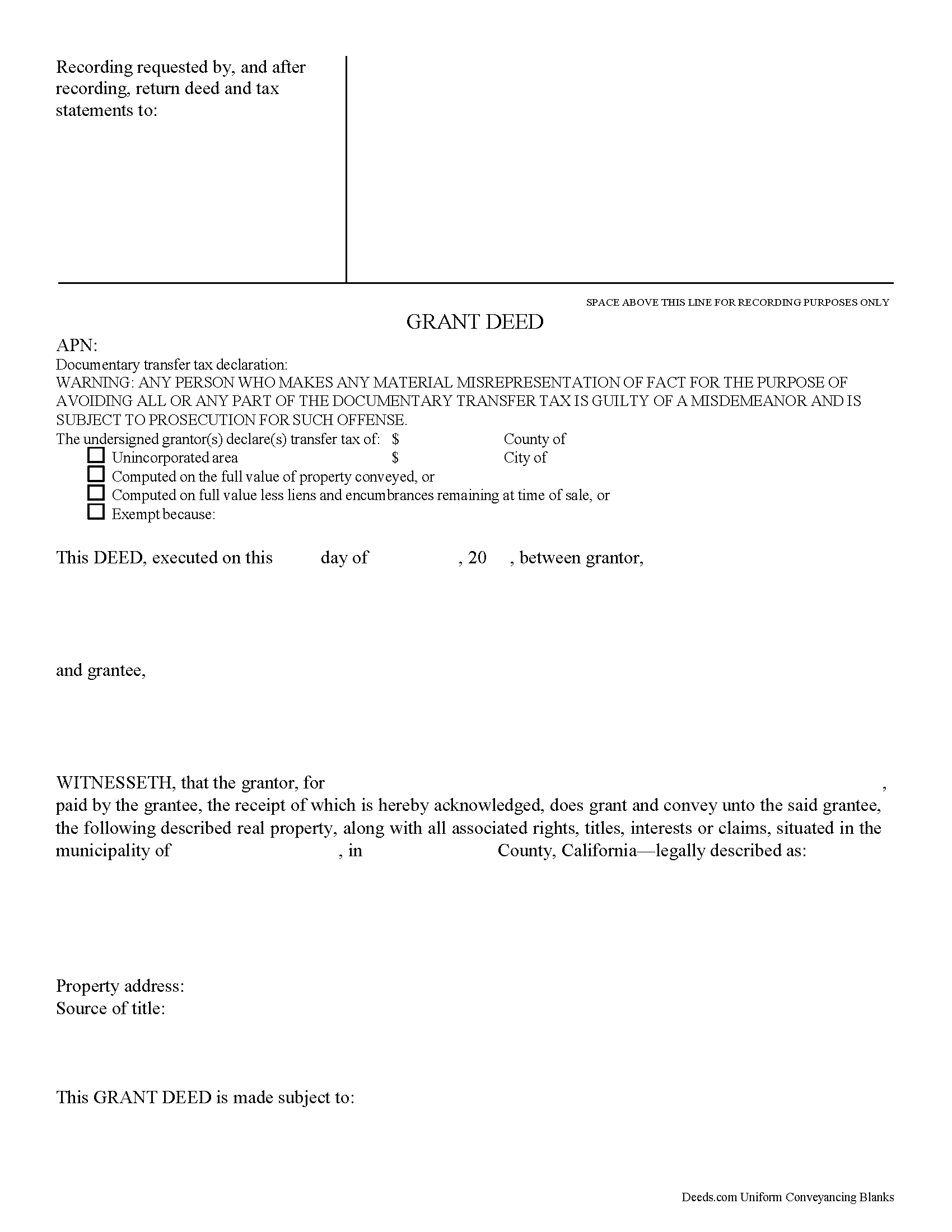
A grant deed is the most commonly used form for a conveyance of real property in California. This type of deed offers more protection to a buyer than a quitclaim deed, but less protection than a warranty deed.
The implied warranties in a grant deed are designed to protect the grantee (purchaser). The grant deed includes the implied warranty that the grantor has not conveyed the title or interest in the property to anyone else and that the property is free from any encumbrances done, made, or suffered by the grantor or any person claiming under him, except for any that may be specifically disclosed in the deed (CIV 1113). The main difference between a warranty deed and a grant deed is that in a warranty deed, the grantor will warrant and defend the title against the claims of all persons.
A grant deed in California requires the grantor's signature, which must also be acknowledged with a California all-purpose acknowledgement. The officer taking acknowledgements must have a certificate of acknowledgement endorsed on the deed (CIV 1188). Grant deeds submitted for recording must be accompanied by a completed Preliminary Change of Ownership Report.
All instruments that are e... More Information about the California Grant Deed
Deed Corrective Affidavit
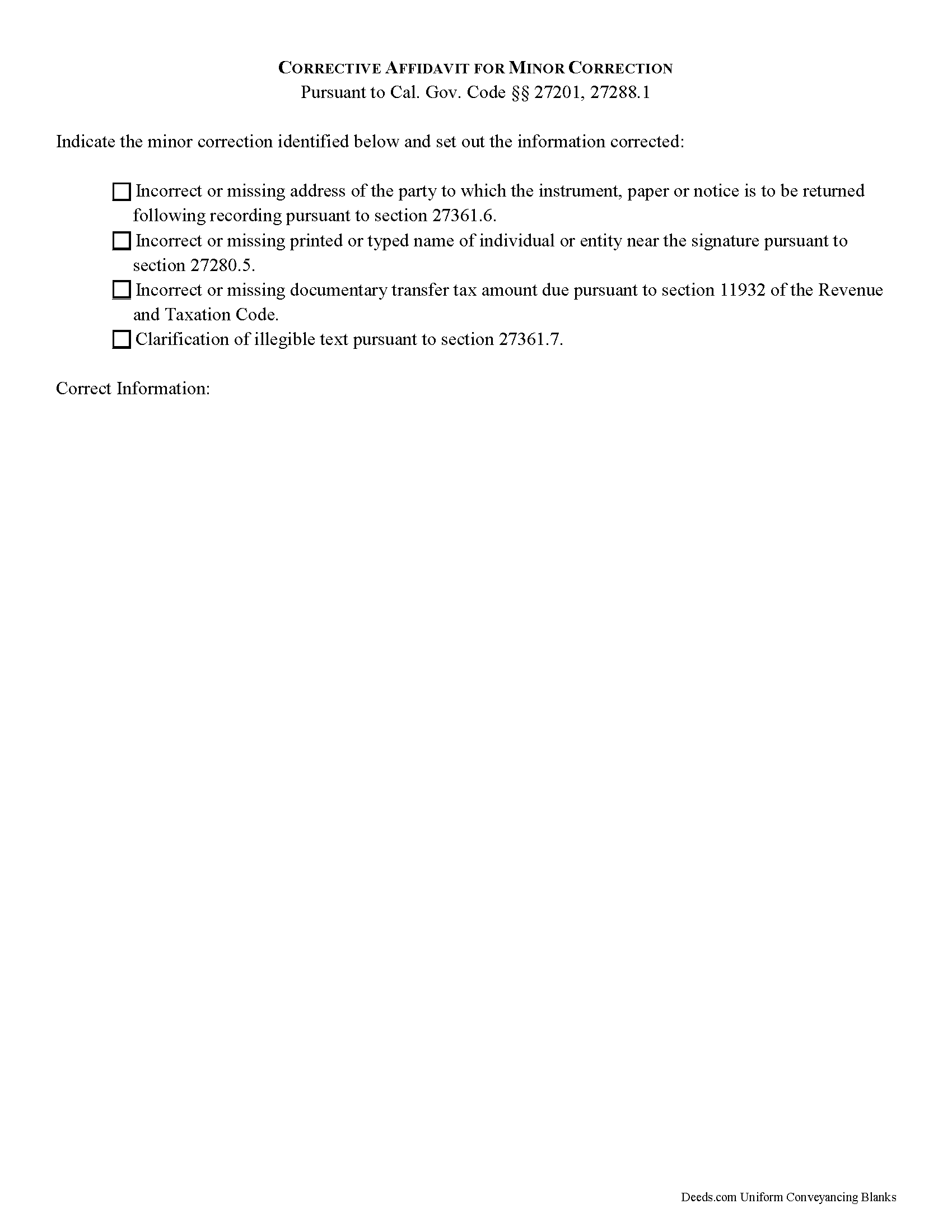
Corrective Affidavits in California
Typically, any rerecorded document must be resigned and acknowledged as a new document. However, an erroneous document will not be recorded as a new document if it is presented with a corrective affidavit (Cal. Gov. Code 27201.). A corrective affidavit is a statutory device under Cal. Gov. Code 27201, used to correct a minor error in a document that has been recorded at an earlier date.
Minor errors are those that, when corrected, cause no actual change in the substance of the document. Section 27201 of the Government Code states that a corrective affidavit can only be used to correct the following: an incorrect or missing return address; a clarification of illegible text; an incorrect or missing printed or typed name near the signature; or an incorrect or missing documentary transfer tax amount due.
More extensive corrections to recorded documents typically require a new deed. Adding or removing a grantee, for example, or making material changes to the legal description, may all require a new document of conveyance. When in doubt about the appropriate vehicle to address the error, consult with a lawyer.
A correction deed is exempt f... More Information about the California Deed Corrective Affidavit
Transfer on Death Deed
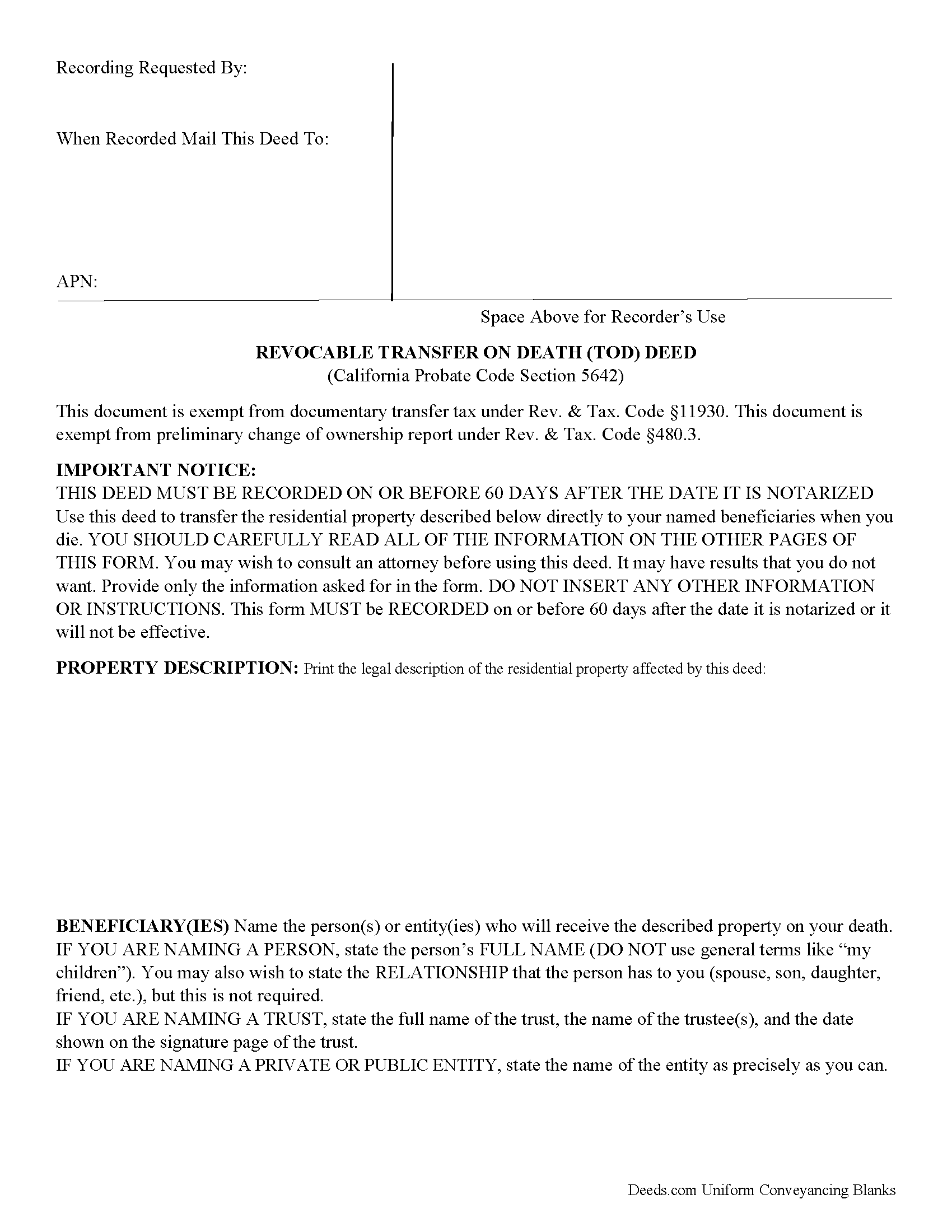
Use this form to transfer real estate at death, but outside of a will and without the need for probate distribution. Execute the TODD form, then record it during the course of your life, and within 60 days of the signing date (5626(a)). Note that unlike grant deeds or quitclaim deeds, there is no change in ownership when transfer on death deeds are recorded (5650), so they are exempt from transfer taxes and the Preliminary Change of Ownership Report (PCOR).
Section 5650 explains that while you are alive, you retain absolute ownership of and control over your property. You may sell, mortgage, rent, or otherwise use the real estate in any lawful manner, without input from or notice to the beneficiaries, or even modify or revoke the future transfer.
Be aware, too, that the TODD is NOT affected by provisions in your will (5642(b)). Best practices dictate that any change to an estate plan initiates a review of the whole thing, so to reduce the chance for conflict, ensure that the transfer on death deed reinforces the will and other related documents.
Beneficiaries take title to the property under the rules set out at section 5652. Any associated debts, obligations, or agreem... More Information about the California Transfer on Death Deed
Transfer on Death Revocation
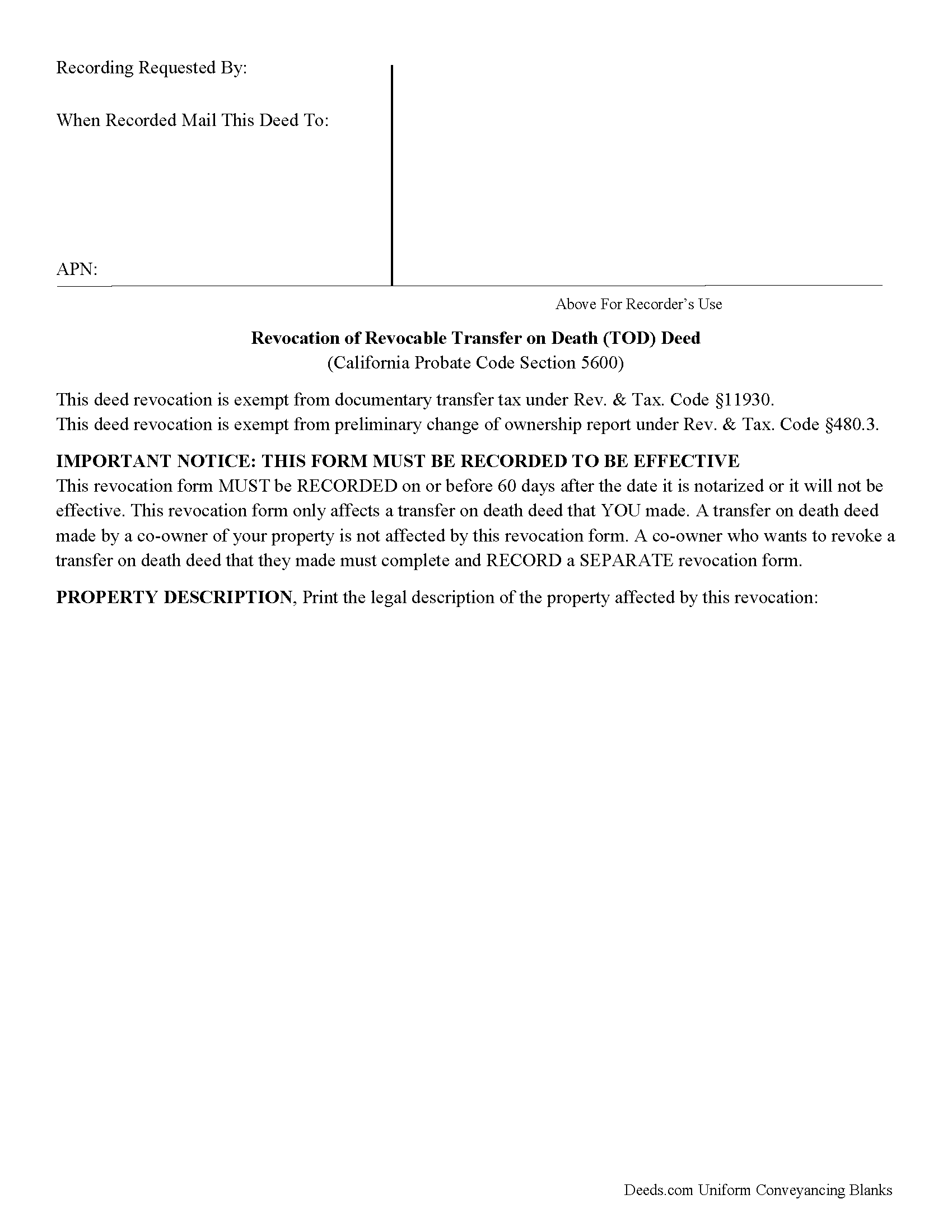
Revoking a Transfer on Death Deed in California
Transfer on death deeds allow individual landowners to transfer their real estate when they die, but outside of a will and without the need for probate. The transferor simply executes a TODD form, then records it during the course of his/her natural life, and within 60 days of the signing date (5626(a)). Unlike grant deeds or quitclaim deeds, however, there is no change in ownership when a transfer on death deed is recorded (5650).
As with transfer on death deeds, any change or revocation must be recorded DURING THE TRANSFEROR'S LIFE or it will be void.
Revocability is one of the unique features of transfer on death deeds. By retaining title to the property, it's easier for the transferor to respond to changes in circumstances or intentions. There are three ways to revoke a recorded TODD: transfer the real estate outright (in other words, use a standard deed, such as a grant or quitclaim deed, to convey the title away from the transferor); execute and record a new TODD, which automatically supersedes the previous document; or execute and record an instrument of revocation (5628-5632, 5660(c)).
While the statute allows th... More Information about the California Transfer on Death Revocation
Transfer on Death Affidavit
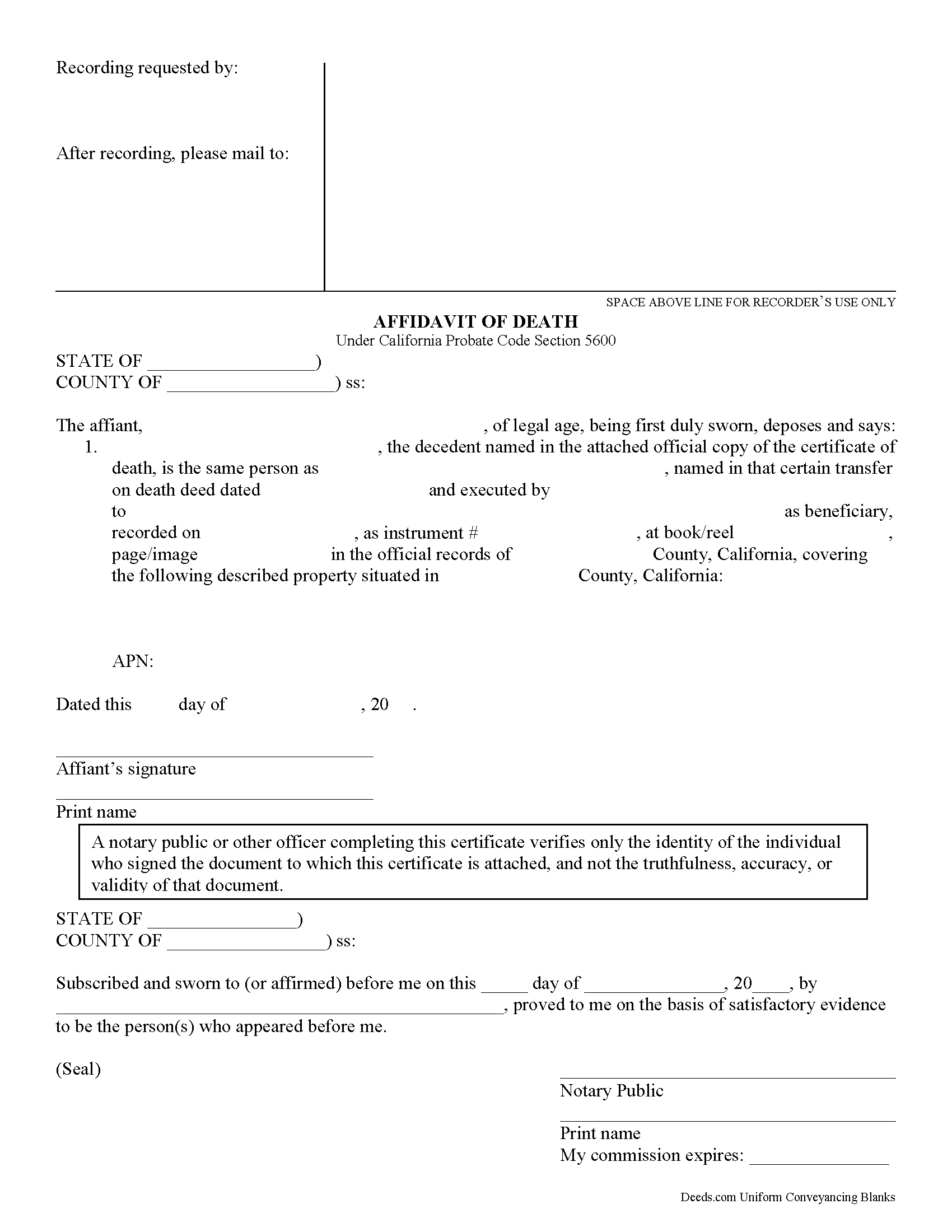
Using an Affidavit of Death to Claim Real Estate from a California Transfer on Death Deed
Transfer on death deeds allow individual landowners to transfer their real estate when they die, without a will or the need for probate distribution. The transferor simply executes a TODD form, then records it during the course of his/her natural life, and within 60 days of the signing date (5626(a)). Unlike grant deeds or quitclaim deeds, the owner continues to hold title to the property when a transfer on death deed is recorded (5650). As such, TODDs are exempt from transfer taxes and the Preliminary Change of Ownership Report (PCOR).
What happens, then, when the owner dies? Section 5680 defines the process for switching the title over to the beneficiary. The beneficiary may establish the fact of the transferor's death under the procedure provided in California Probate Code Chapter 2 (commencing with Section 210) of Part 4 of Division 2. The first step is obtaining a certified copy of the death certificate. Then research the recording information from the transfer on death deed identifying the beneficiary. Complete an affidavit of death and sign it in front of a notary. Finally, file ... More Information about the California Transfer on Death Affidavit
Interspousal Transfer Grant Deed
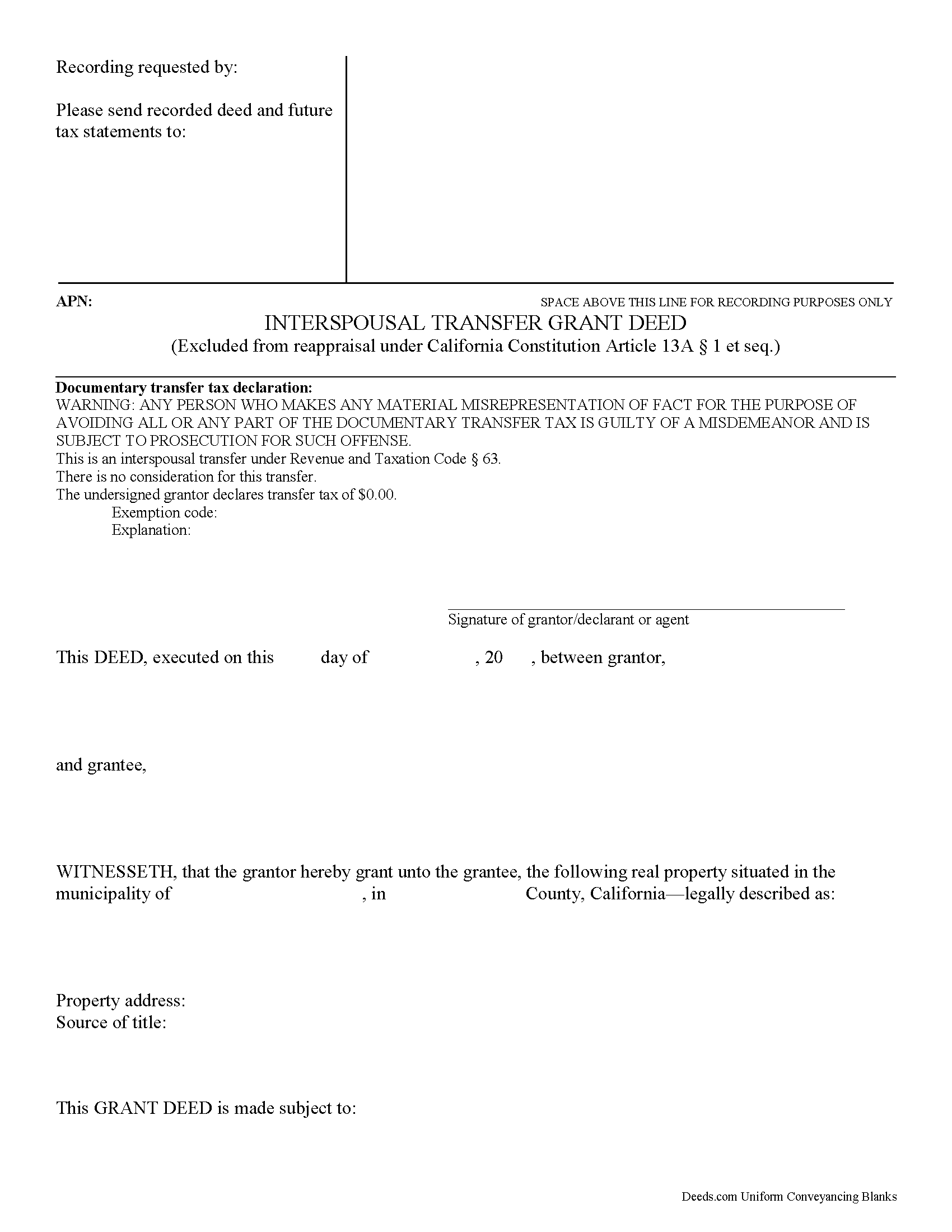
A California Interspousal Transfer Grant Deed is used to create, transfer, or terminate a real property ownership interest between spouses. This instrument applies to a present owner's interest and has been drafted to comply with the Revenue and Taxation Code Section 63.
A transfer of real property ownership interests between spouses is excluded from reappraisal under the California Constitution Article 13 A &1 et seq. and transfer taxes, as this conveyance establishes sole and separate property of a spouse (RT 11911)
(California Interspousal Transfer Grant Deed Package includes form, guidelines, and completed example)... More Information about the California Interspousal Transfer Grant Deed
Grant Deed for Life Estate
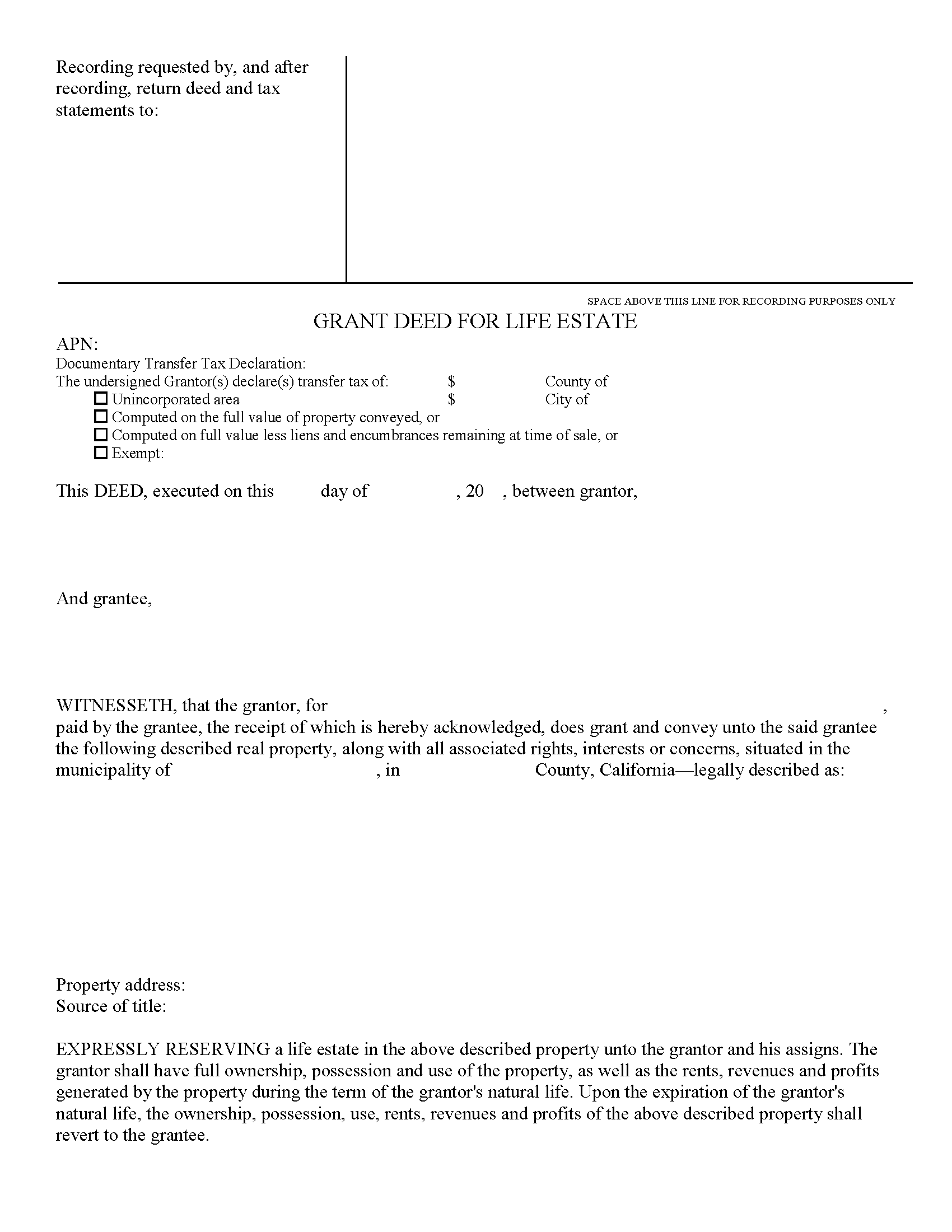
This life estate deed is a document that transfers ownership of real property, while reserving access and use of the property for the duration of the grantor's life. It allows the original owner (grantor) to remain on the premises with full access to and benefits from the property. The grantee under the deed reserving a life estate for the grantor is not entitled to possession of the property until the grantor dies.
(California Grant Deed for Life Estate Package includes form, guidelines, and completed example)... More Information about the California Grant Deed for Life Estate
Easement Deed
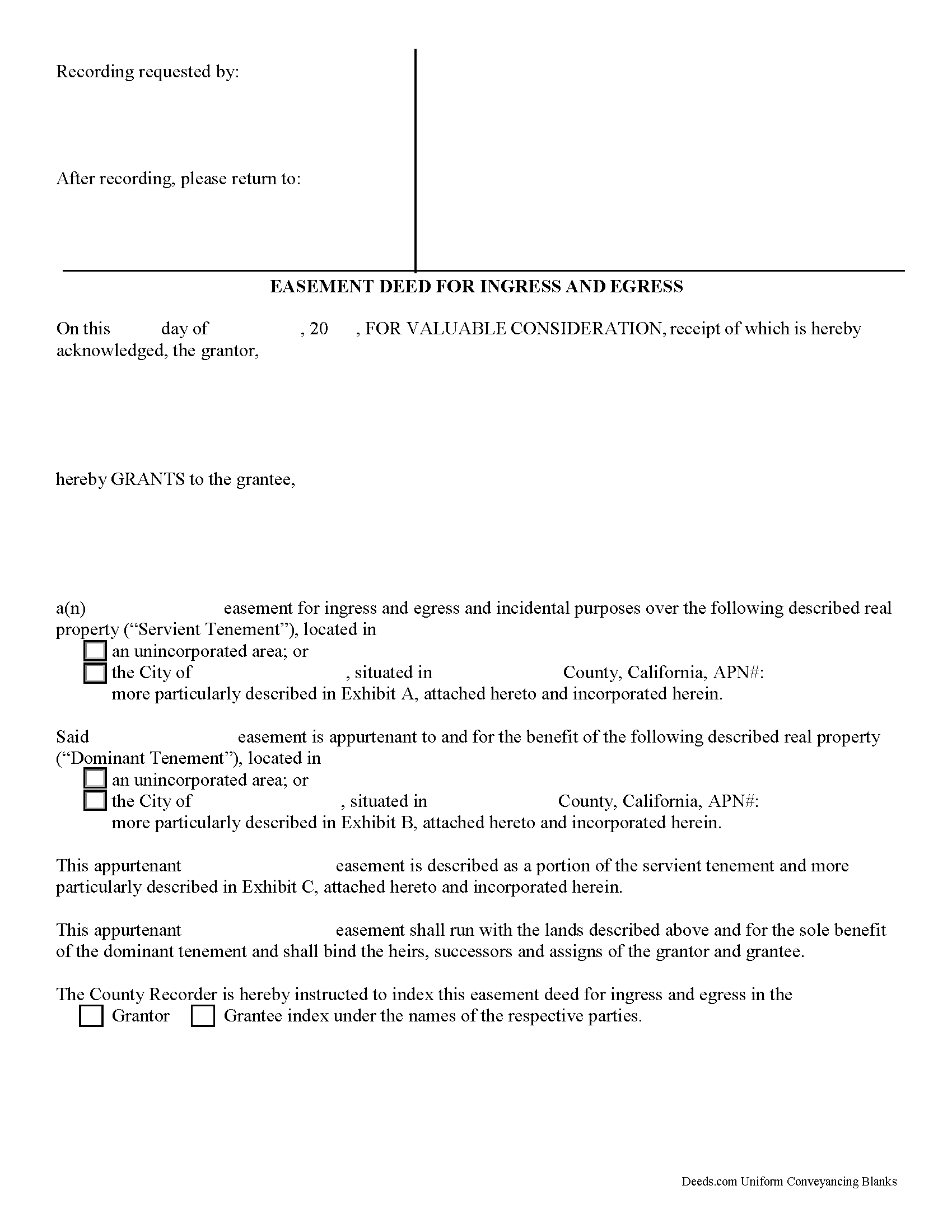
An easement is a non-possessory interest in another person's property that gives someone the right to use another person's property for a specific purpose. An easement can be acquired in many different ways: by an express grant, by prescription, by necessity, by implication, and by condemnation. Easements can be conveyed by deed, will, or contracts.
A transfer of real property in California will pass all the easements attached to the property and creates in favor thereof an easement to use other real property of the person whose estate is transferred in the same manner and to the same extent as such property was obviously and permanently used by the person whose estate is transferred, for the benefit thereof, at the time when the transfer was agreed upon or completed (CIV 1104).
Section 801 of the Civil Code of the California laws lists a number of land burdens, or servitudes upon land, which may be attached to other land as incidents or appurtenances as easements. A servitude (the land upon which a burden or servitude is laid) can only be created by someone who has a vested interest in the servient estate (CIV 804). Additionally, a conservation easement can be created for t... More Information about the California Easement Deed
Termination, Cancellation of Easement / Right of Way
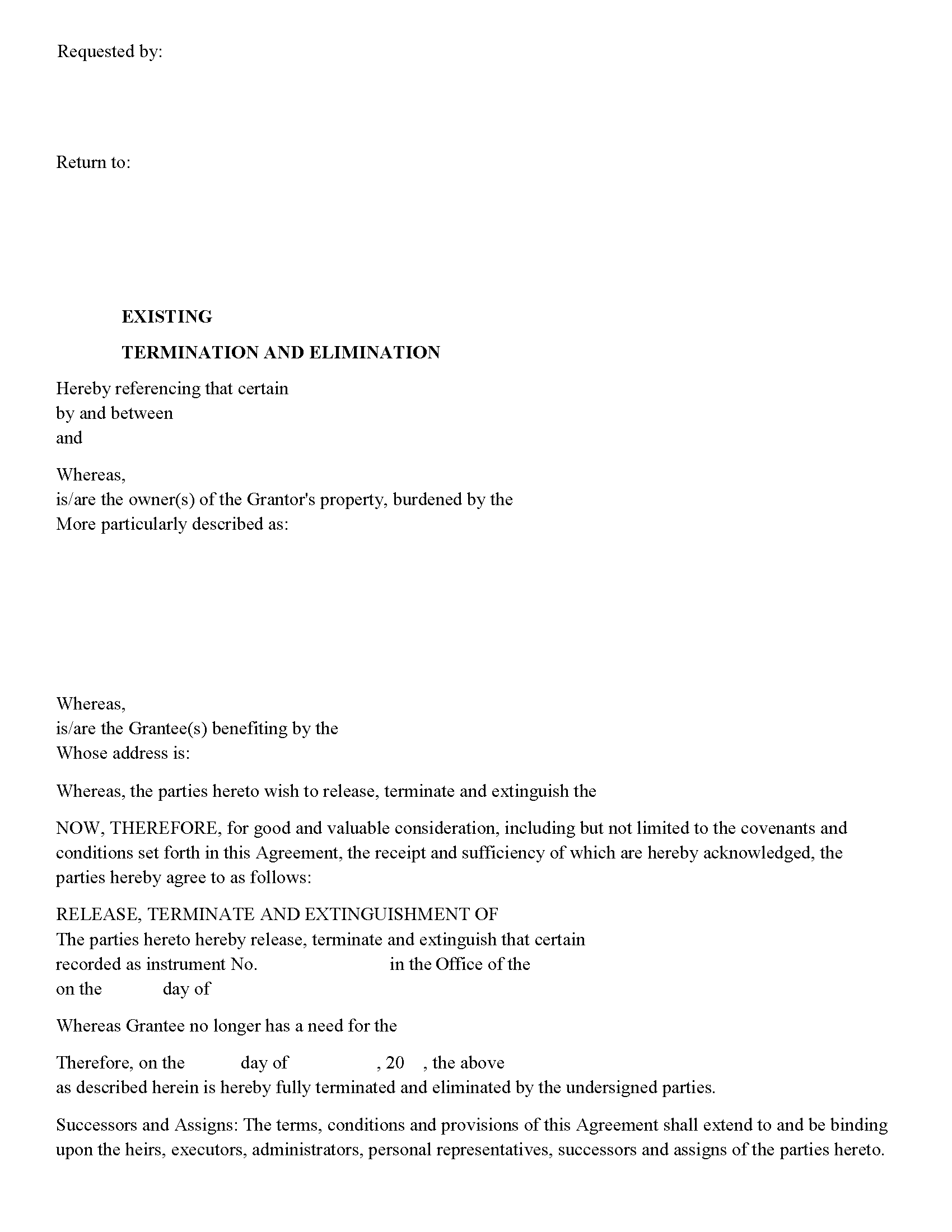
Use this form to release, terminate, extinguish a previously recorded document that involves access to and from a property.
Documents such as:
1. Easement Deeds or Agreements (An easement is a non-possessory interest in land, granting the right to use someone else's property for a specific purpose, like a driveway or utility line)
2. Access Roads
3. Right of Ways
4. Utility Easements (Power, Gas, Water, Sewer, Etc.)
5. Drainage Easements
This document allows the owner of the land, burdened by the access and the party that benefits from the access, to sign an agreement releasing the property from such access, ... More Information about the California Termination, Cancellation of Easement / Right of Way
Special Durable Power of Attorney for the Sale of Property
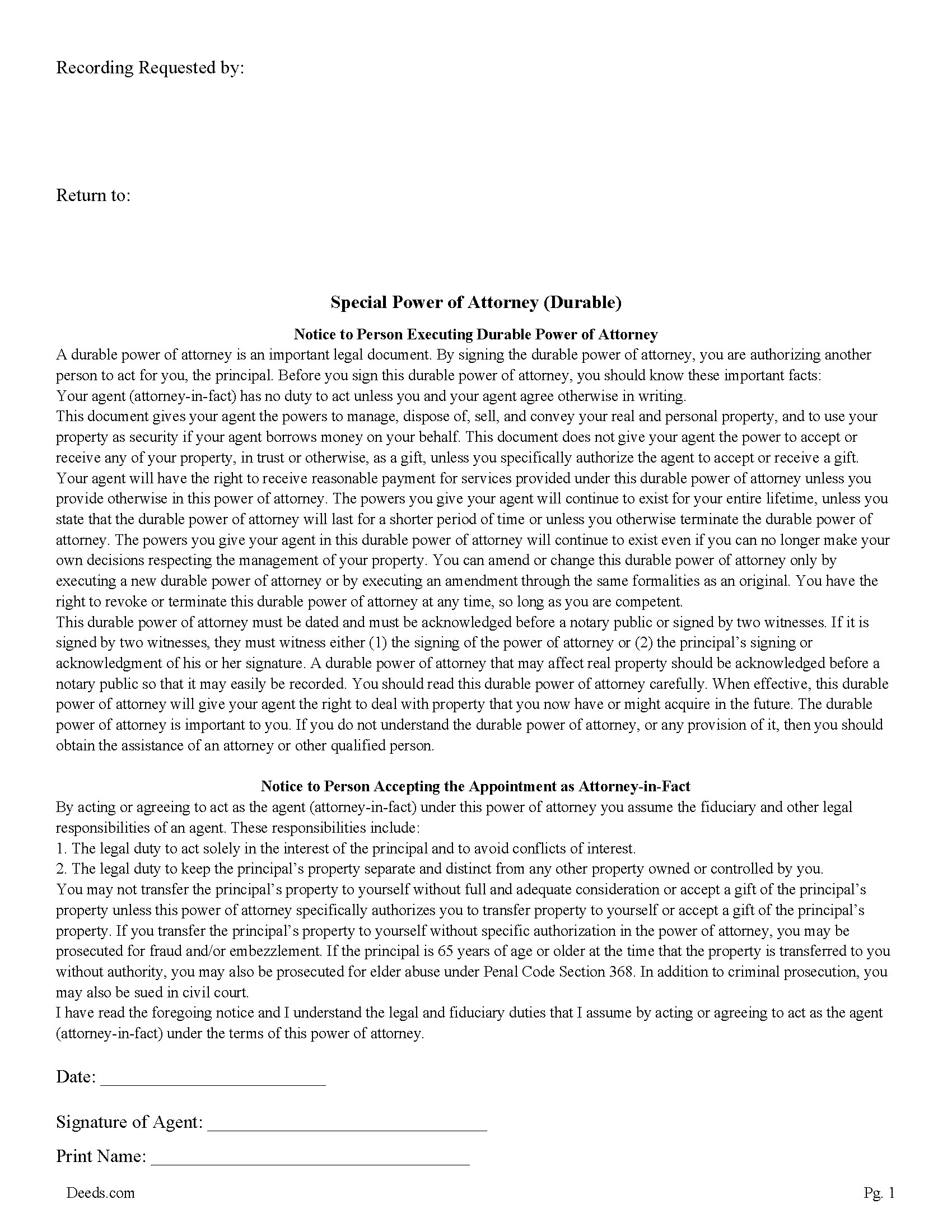
This document creates a durable, special power of attorney for the sale of California real estate. A power of attorney is a legal document delegating authority from one person to another. In the document, the maker of the power of attorney (the "principal") grants the right to act on the maker's behalf as that person's Attorney-in-fact.
Attorney-in-fact means a person granted authority to act for the principal in a power of attorney, regardless of whether the person is known as an attorney-in-fact or agent, or by some other term. CA Prob Code 4014(a)
This special power of attorney grants the attorney-in fact the power to execute, acknowledge and deliver any and all documents, and to do any and all things on behalf of the principal, including, but not limited to, the execution of deeds, notes, mortgages, deeds of trusts, personal guarantees and any other instrument or agreement of any kind or nature whatsoever in connection therewith, and affecting the SALE of a described real property. It includes a "special instructions" section which can be used to further limit or define the powers given.
This instrument is to be construed and interpreted as a durable power of attorney... More Information about the California Special Durable Power of Attorney for the Sale of Property
Special Durable Power of Attorney for the Purchase of Property
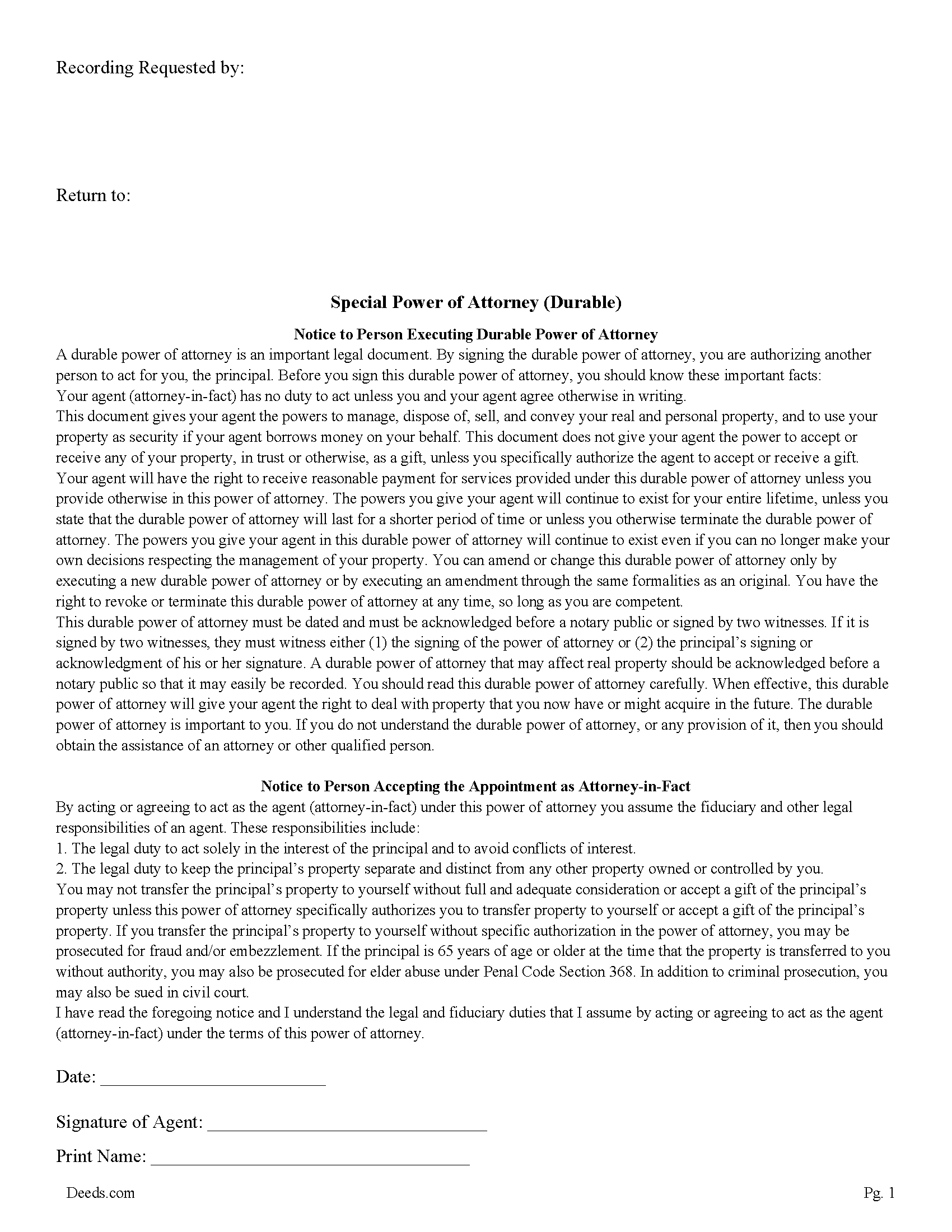
This document creates a durable, special power of attorney for the PURCHASE of California real property. A power of attorney is a legal document delegating authority from one person to another. In the document, the maker of the power of attorney (the "principal") grants the right to act on the maker's behalf as that person's Attorney-in-fact.
Attorney-in-fact means a person granted authority to act for the principal in a power of attorney, regardless of whether the person is known as an attorney-in-fact or agent, or by some other term. CA Prob Code 4014(a)
This special power of attorney grants the attorney-in fact the power to execute and deliver on the principal's behalf, name and stead, any in all necessary legal documents including contracts for sale, deeds, mortgages, deeds of trusts, promissory notes, settlement statements, affidavits, and other documents with regard to all matters concerning the PURCHASE of a specific property. It includes a "special instructions" section which can be used to further limit/define the powers given.
This instrument is to be construed and interpreted as a durable power of attorney that takes effect immediately and (this power of attorne... More Information about the California Special Durable Power of Attorney for the Purchase of Property
Affidavit Death of Joint Tenant
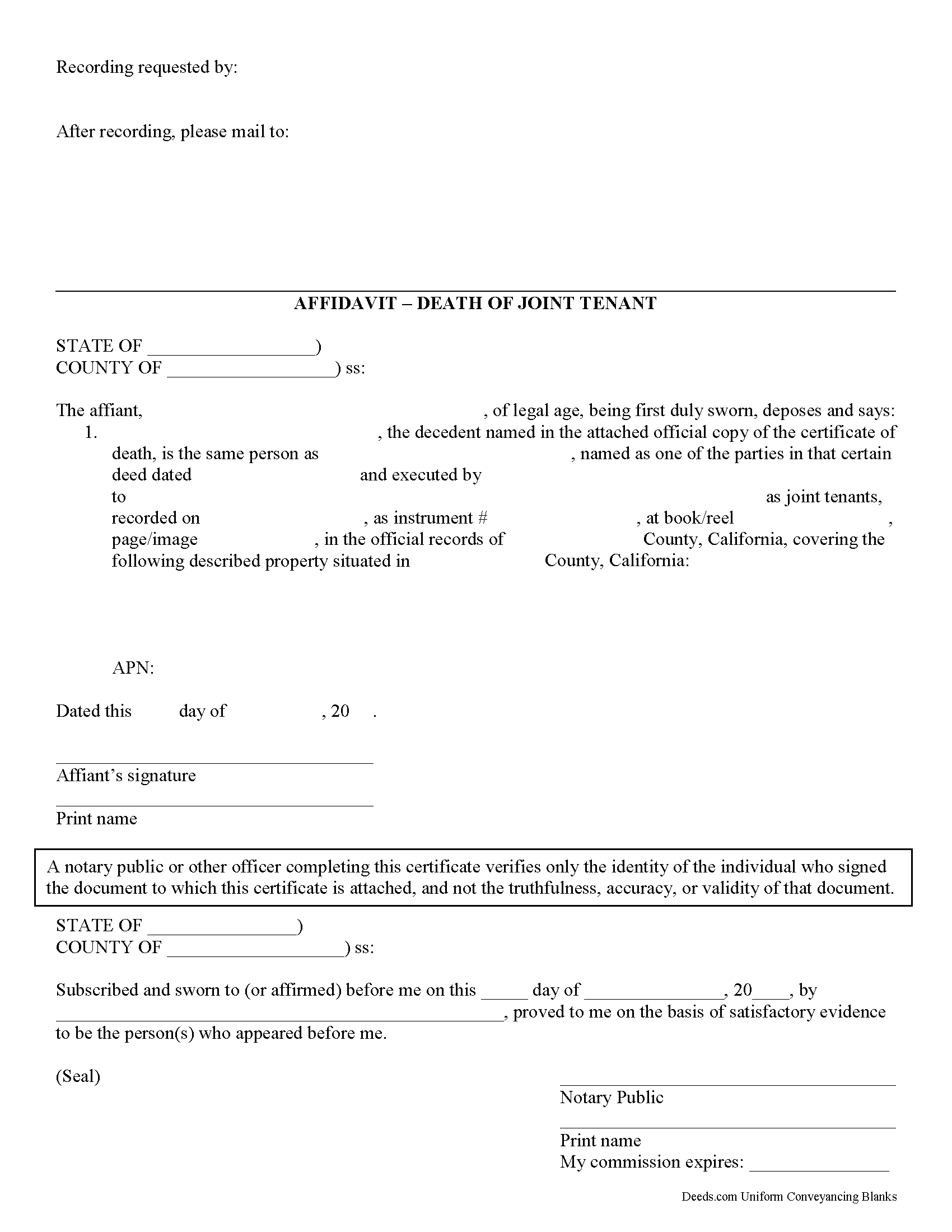
When real estate in California is owned by joint tenants and one of the owners dies, the remaining owner(s) can clear the title by recording an affidavit of Death of a Joint Tenant.
Joint tenancy is a way for two or more people to own property in equal shares so that when one of the joint tenants dies, the property can pass to the surviving joint tenant(s) without having to go through probate court.
The affidavit should be recorded in order to be binding on others. Take a certified copy of the death certificate of the deceased joint tenant and your affidavit to the recorder's office in the county where the real property is located.
(California Affidavit of Death of Joint Tenant Package includes form, guidelines, and completed example)... More Information about the California Affidavit Death of Joint Tenant
Affidavit of Surviving Spouse
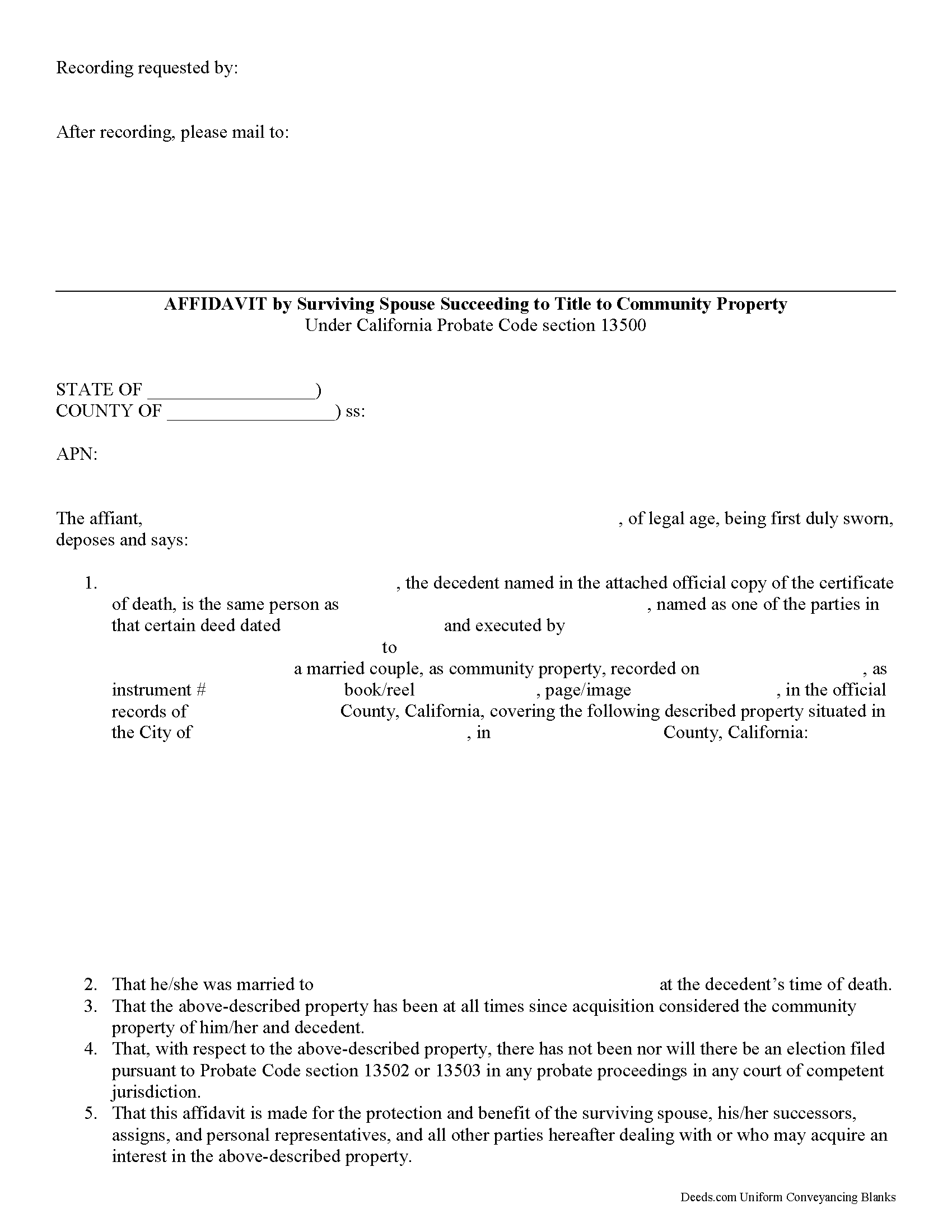
Transferring California Community Property to the Surviving Spouse
Section 100(a) of the California Probate Code states that when a married person dies, one-half of the couple's community property belongs to the surviving spouse and the other half stays in the decedent's name, ostensibly for probate distribution. For transfers occurring after July 1, 2001, California property owners gained the option to hold title as community property with the right of survivorship. By vesting this way, the remaining spouse acquires the deceased spouse's portion of the shared property without the need for probate (Cal Civ Code 682.1(a)).
The surviving spouse files an affidavit (a statement of facts, made under oath), along with an official copy of the death certificate, at the recording office for the county where the property is located. The content may vary depending on the circumstances, but it generally contains the names of both spouses, a formal legal description of the shared real estate, and the recording information for the deed transferring ownership to the couple, confirming their intention to hold title as community property. Note that the right of survivorship is not automatic ... More Information about the California Affidavit of Surviving Spouse
Long Form Deed of Trust
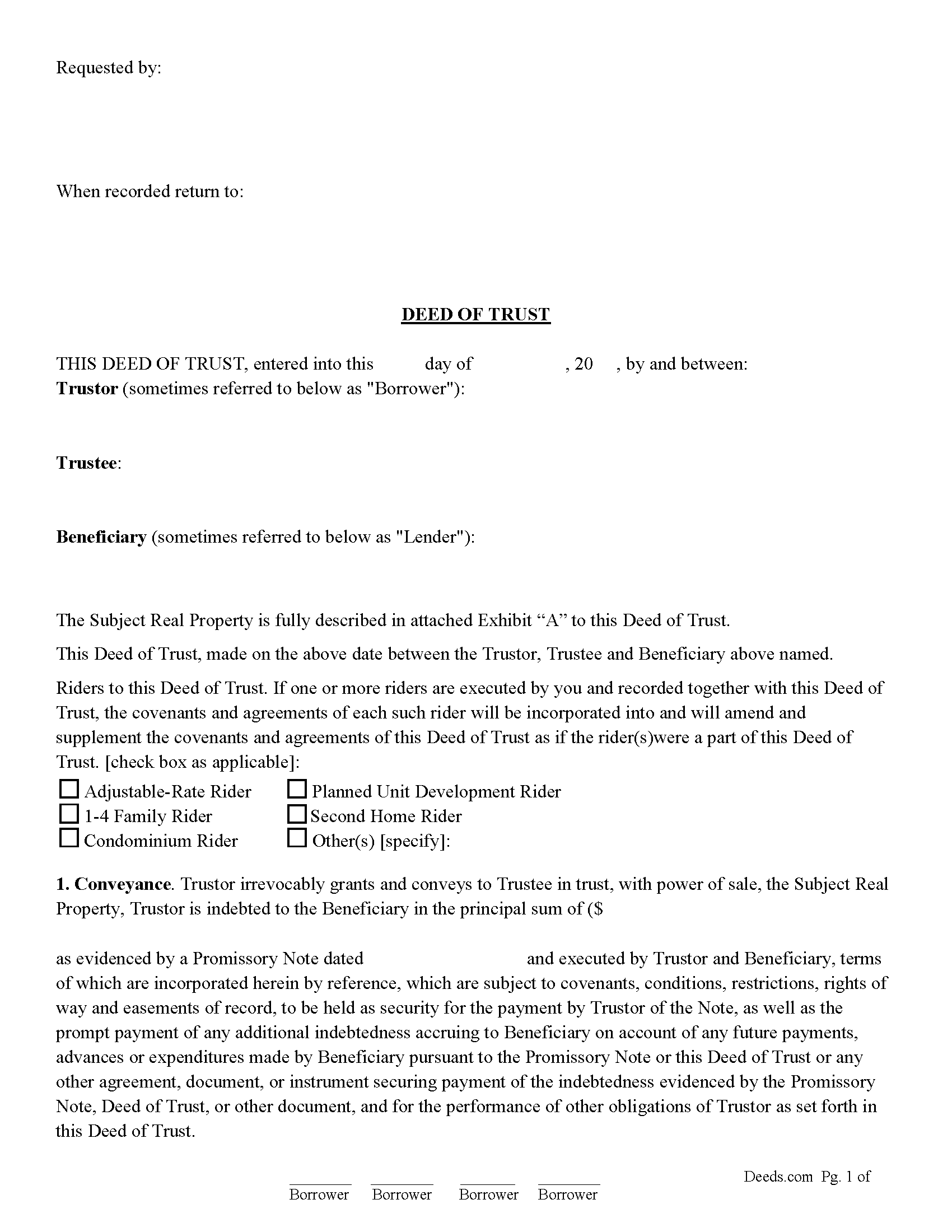
A deed of trust (DOT), also known as a trust deed, is a document that conveys title to real property to a trustee as security for a loan until the grantor (borrower) repays the lender according to terms defined in the promissory note. It's similar to a mortgage but differs in that mortgages only include two parties (borrower and lender). The laws of each state determine whether to use a deed of trust or a mortgage.
This form may be used for residential property, condominiums, second homes, vacant land, planned unit developments, small commercial and rental property with up to 4 units, if more than 4 units-attach our assignment of leases and rents form.
This DOT contains a Power of Sale Clause allowing for a non-judicial foreclosure, saving time and expense for the lender. The promissory note can be used for installment or balloon payments. A deed of trust and promissory note containing stringent default terms can be beneficial to the Beneficiary/Lender.
(California Long Form Deed of Trust Package includes forms, guidelines, and completed examples) For use in California only.... More Information about the California Long Form Deed of Trust
Assignment of Deed of Trust
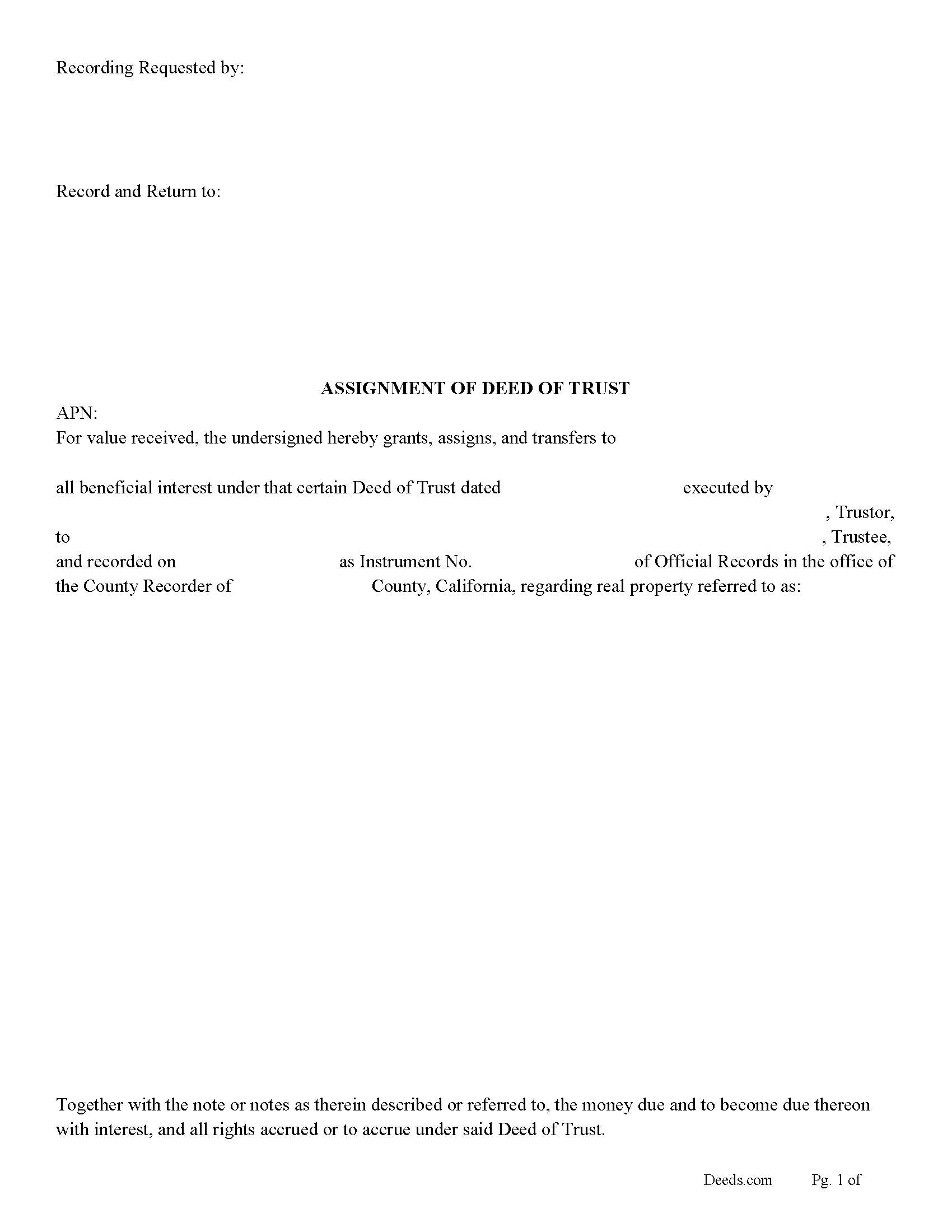
The current Lender/Beneficiary uses this form to assign a Deed of Trust to another lender. This is often done when a Deed of Trust has been sold. This allows the new Lender the right to collect payments of the debt. A typical Deed of Trust contains a Power of Sale clause, allowing a non-judicial foreclosure. (The power of sale may be exercised by the assignee if the assignment is duly acknowledged and recorded.) (California Code 2932.5)
Current Borrowers must be notified of the assignment. Notification consists of contact information of the new creditor, recording dates, recording instrument numbers, changes in loan, etc. Included are "Notice of Assignment of Deed of Trust" forms.
The Truth and lending act requires that borrowers be notified when their deed of trust debt has been sold, transferred, or assigned to a new creditor. Generally, within 30 days to avoid up to $2,000.00 in statutory damages, plus reasonable attorney's fees. Systematic violations can reach up $500,000.00.
(California Assignment of Deed of Trust Package includes form, guidelines, and completed example) For use in California only.
... More Information about the California Assignment of Deed of Trust
Substitution of Trustee and Full Reconveyance
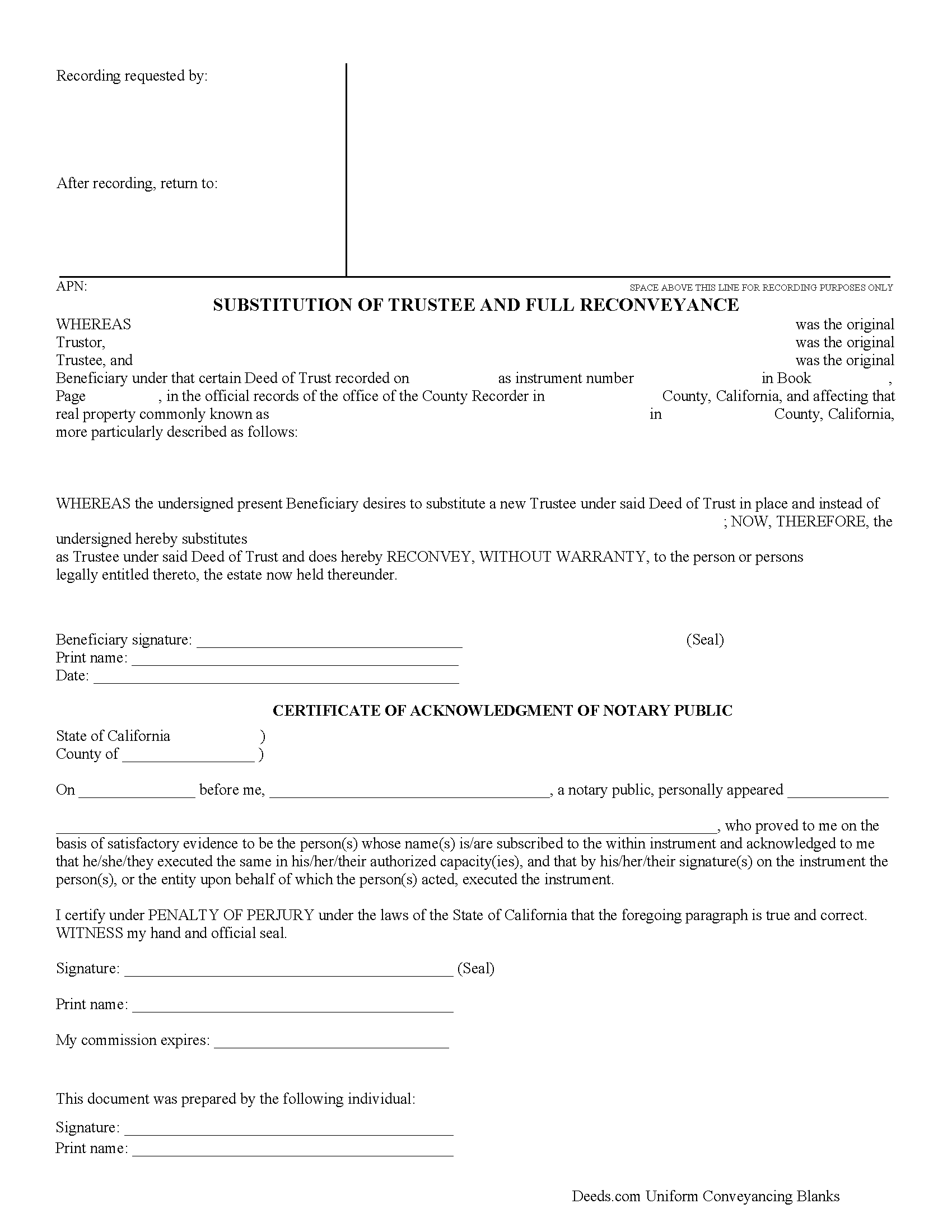
California Substitution of Trustee and Full Reconveyance
Sometimes the original trustee on a deed of trust is unable or unwilling to perform his/her responsibilities. In that case, the beneficiary/lender uses this form to authorize a substitute trustee, who, by recording it, will release the lien and convey the land with a clear title.
California Code, Civil Code - CIV 2941
(2) If the trustee has failed to execute and record, or cause to be recorded, the full reconveyance within 60 calendar days of satisfaction of the obligation, the beneficiary, upon receipt of a written request by the trustor or trustor's heirs, successor in interest, agent, or assignee, shall execute and acknowledge a document pursuant to Section 2934a substituting itself or another as trustee and issue a full reconveyance.
(California Reconveyance Package includes form, guidelines, and completed example)
... More Information about the California Substitution of Trustee and Full Reconveyance
Deed of Full Reconveyance
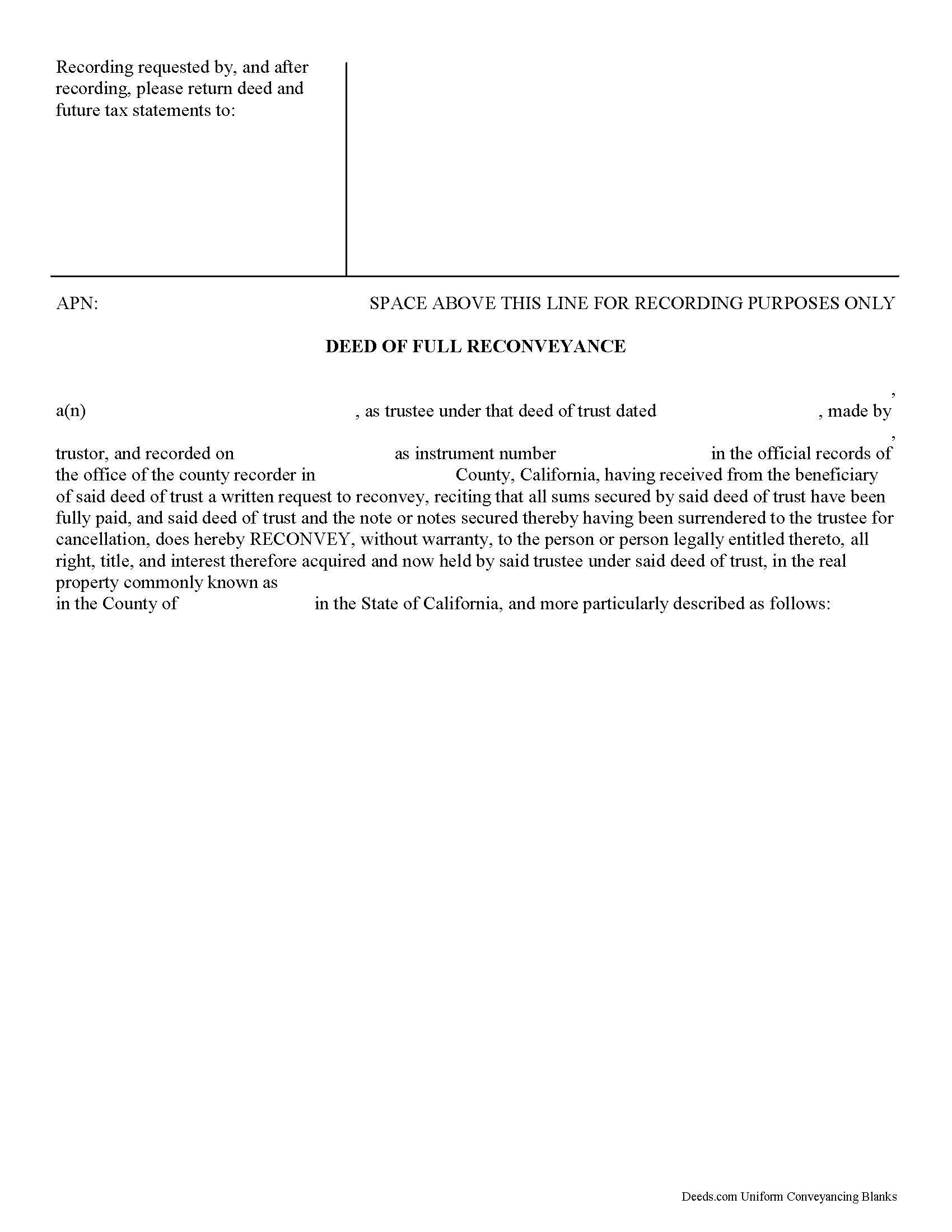
After paying off a deed of trust secured by a promissory note, the trustee records this document to clear the lien and convey clear title to the borrower.
(California Reconveyance Package includes form, guidelines, and completed example)... More Information about the California Deed of Full Reconveyance
Memorandum and Notice of Agreement
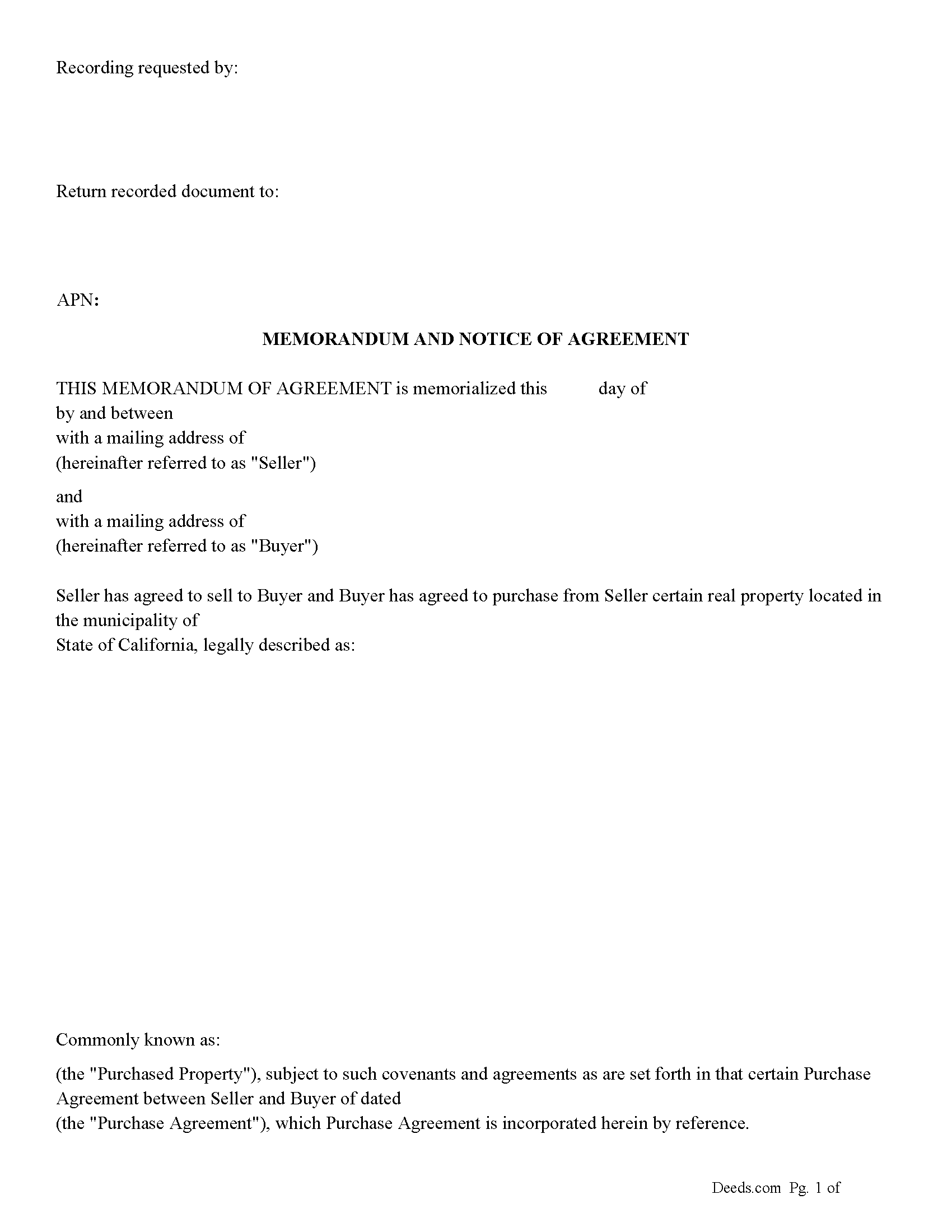
A "Memorandum of Purchase Agreement" commonly referred to as a "Memorandum of Agreement" (MOA), Memorandum of Contract (MOC) or "Memorandum of Understanding" (MOU) in the context of real estate, is used primarily as a means to provide public notice of an equitable interest in a real estate transaction without disclosing the full details of the purchase agreement. This document is particularly useful in transactions where the buyer and seller have agreed to terms but the final closing and transfer of the deed have not yet occurred. By recording this memorandum with the county recorder's office, the buyer establishes a public record of their interest in the property, which can protect against subsequent claims or liens by third parties.
Key Purposes of a Memorandum of Purchase Agreement:
1. Notice of Equitable Interest: The memorandum serves as notice to the public that the buyer has an equitable interest in the property due to the purchase agreement. This is important in protecting the buyer’s interest against claims by other parties who might otherwise be unaware of the agreement.
2. Protection During the Closing Process: Real estate transactions can involve a lengthy clo... More Information about the California Memorandum and Notice of Agreement
Assignment of Leases and Rents
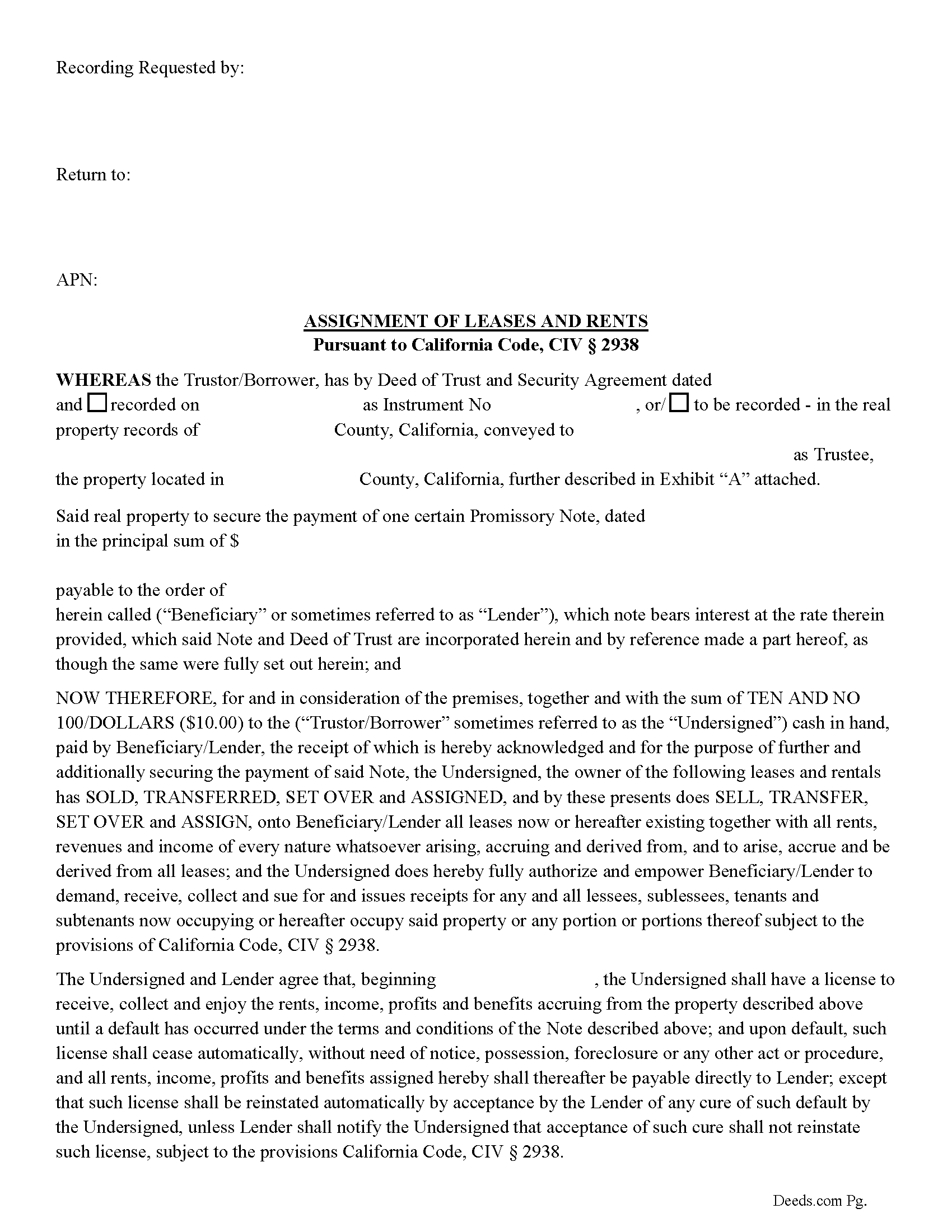
This Form can be attached to a deed of trust document upon recordation or recorded separately to reference a previously recorded deed of trust. The undersigned (typically the borrower) shall have a license to receive, collect and enjoy the rents, income, profits and benefits accruing from the property described above until a default has occurred under the terms and conditions of the promissory note described. Upon default the Beneficiary/Lender delivers a "demand to pay form", to existing tenants/lessees pursuant to (SECTION 2938 OF THE CA. CIVIL CODE)
An assignment of an interest in leases, rents, issues, or profits of real property may be recorded in the records of the county recorder in the county in which the underlying real property is located in the same manner as any other conveyance of an interest in real property, whether the assignment is in a separate document or part of a mortgage or deed of trust, and when so duly recorded in accordance with the methods, procedures, and requirements for recordation of conveyances of other interests in real property, (1) the assignment shall be deemed to give constructive notice of the content of the assignment with the same force an... More Information about the California Assignment of Leases and Rents
Release of Assignment of Leases and Rents.
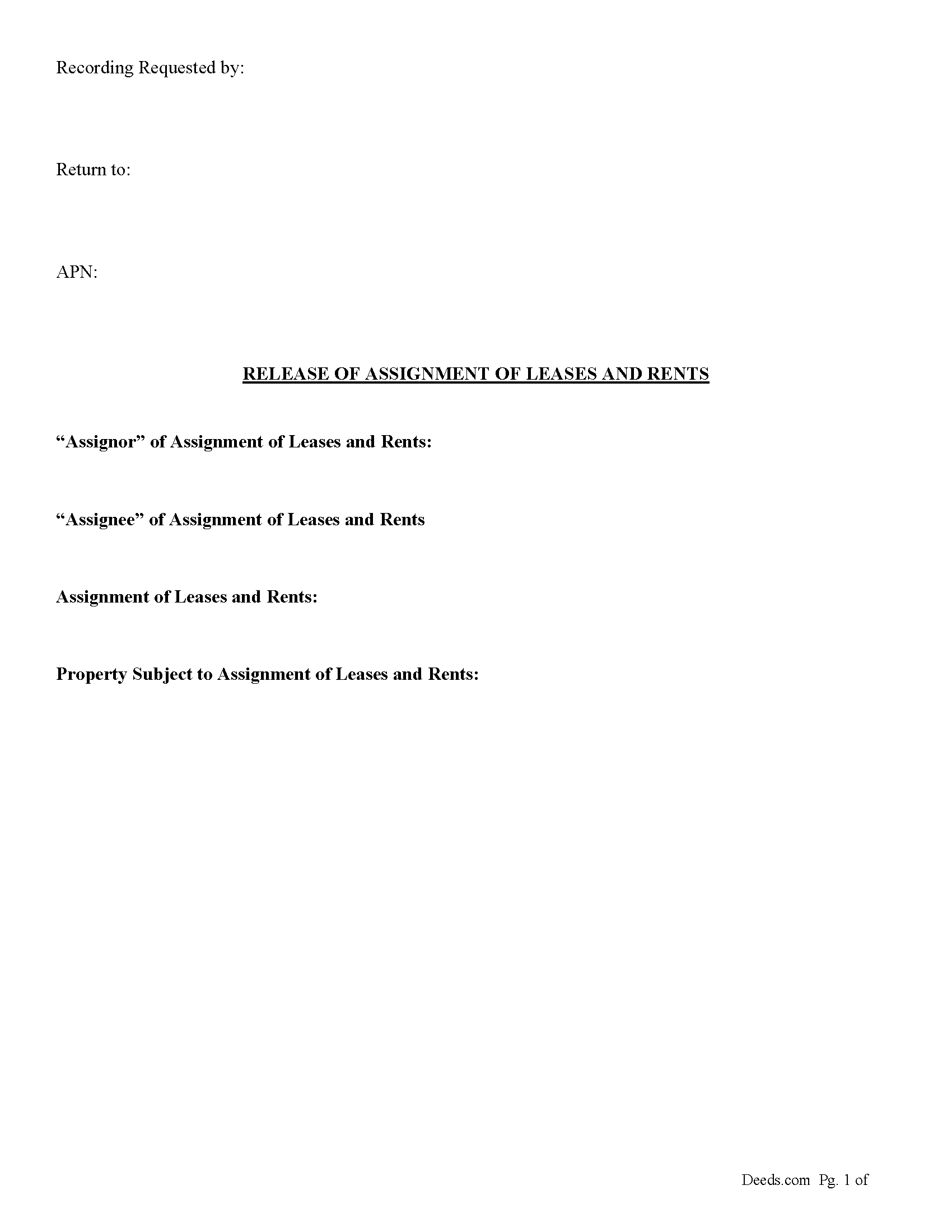
Use this form to release a previously recorded Assignment of Rents and Leases. An assignment of leases and rents is usually recorded to protect the Lender in the case of default, a release of assignment of Leases and rents is recorded once the lender is paid in full.
California Civil Code 2938 (b) An assignment of an interest in leases, rents, issues, or profits of real property may be recorded in the records of the county recorder in the county in which the underlying real property is located in the same manner as any other conveyance of an interest in real property, whether the assignment is in a separate document or part of a mortgage or deed of trust, and when so duly recorded in accordance with the methods, procedures, and requirements for recordation of conveyances of other interests in real property, (1) the assignment shall be deemed to give constructive notice of the content of the assignment with the same force and effect as any other duly recorded conveyance of an interest in real property and (2) the interest granted by the assignment shall be deemed fully perfected as of the time of recordation with the same force and effect as any other duly recorded conveyance of ... More Information about the California Release of Assignment of Leases and Rents.
Personal Representative Deed
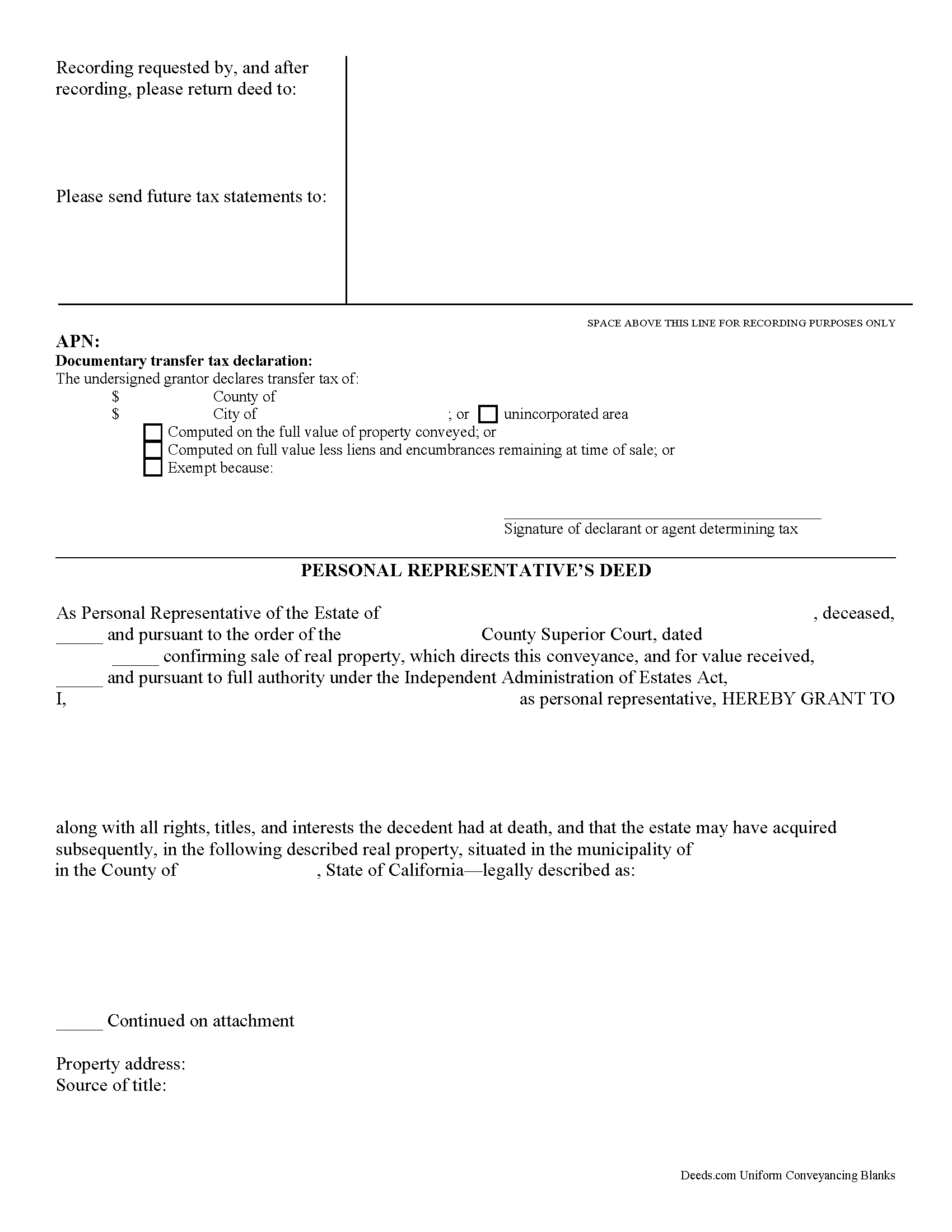
Personal representative's deeds are used to transfer real property from both testate (with a will) and intestate (without a will) estates. These documents provide essential information about the specific probate estate and related property transfer in one document.
When a person dies, the probate court authorizes someone to take responsibility for distributing the remaining assets according to the instructions set out in the decedent's will (if one exists), while also following state and local laws. This person is often known as an executor or an administrator of the estate. California, however, identifies the individual who accepts that fiduciary duty as a personal representative (PR).
One common task involves transferring title on the decedent's real estate. Deeds used for this purpose must meet the same state and local requirements as warranty or quitclaim deeds. They also include other details, such as facts about the deceased property owner, the probate case, and anything else deemed necessary by the situation. In addition, the PR must file a PCOR with the county assessor's office when recording the completed deed.
Note that these deeds may need to be recorded with th... More Information about the California Personal Representative Deed
Disclaimer of Interest
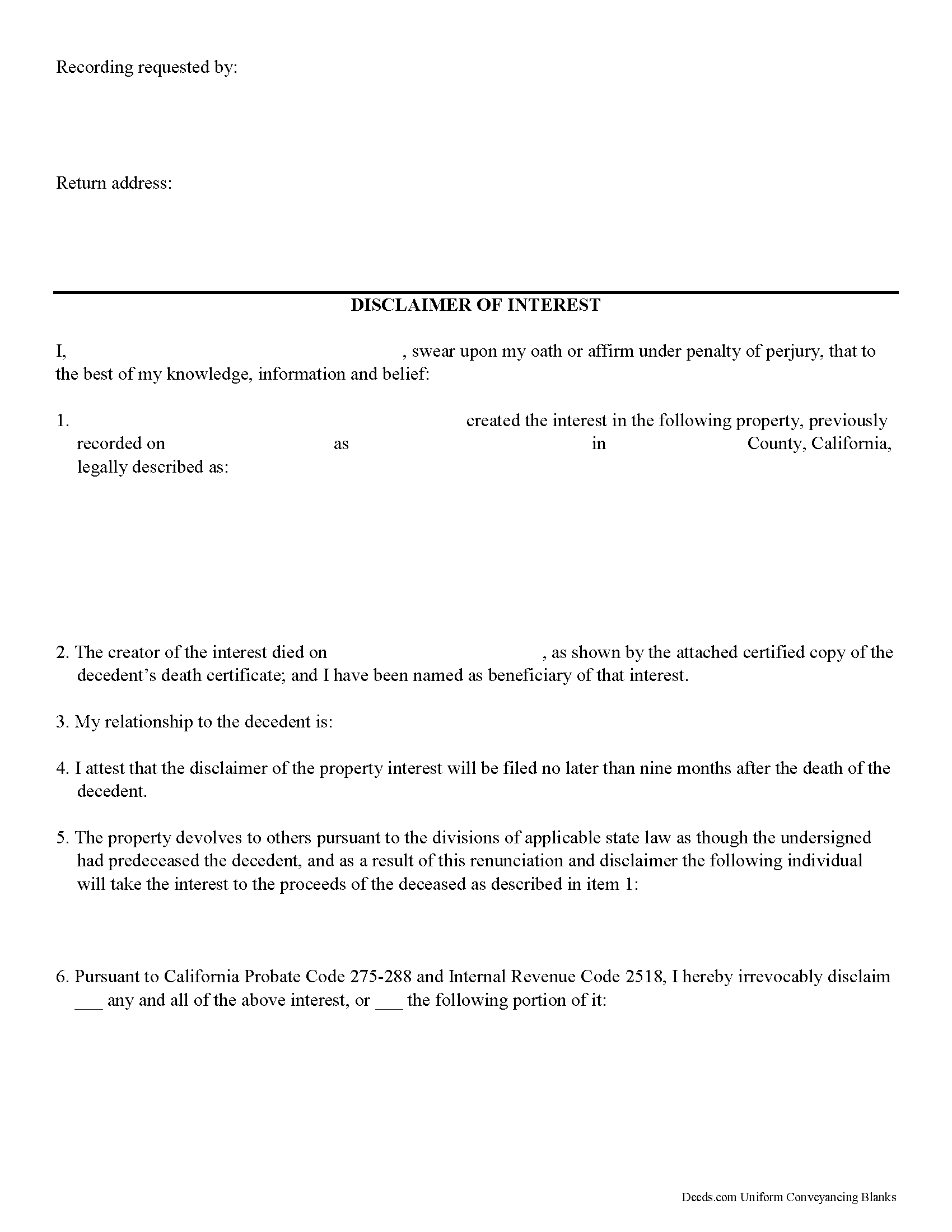
Use the disclaimer to renounce an interest in real property in California.
A beneficiary in California can disclaim a bequeathed asset or power. For a complete list, see Probate Code 267. A disclaimer, which must be in writing and signed by the beneficiary, allows that beneficiary to renounce his or her interest in the property. California statutes allow for the partial rejection of the interest, which must be clearly identified on the disclaimer.
Besides the beneficiary, state the name of the creator of the interest, as well as the next beneficiary to whom the interest will pass, e.g., the next person in line to inherit. In the case of real property, give the entire legal description of the land and provide recording information for the prior deed in order to avoid any problems in the chain of title.
A disclaimer is irrevocable and binding for anyone who makes a claim against the beneficiary, for example, potential creditors. It must be received within nine months after the decedent's death, the transfer, or the 21st birthday of the beneficiary (Probate Code 279) and is only valid if no actions have indicated acceptance of the property.
It must be filed with any of t... More Information about the California Disclaimer of Interest
Preliminary Notice
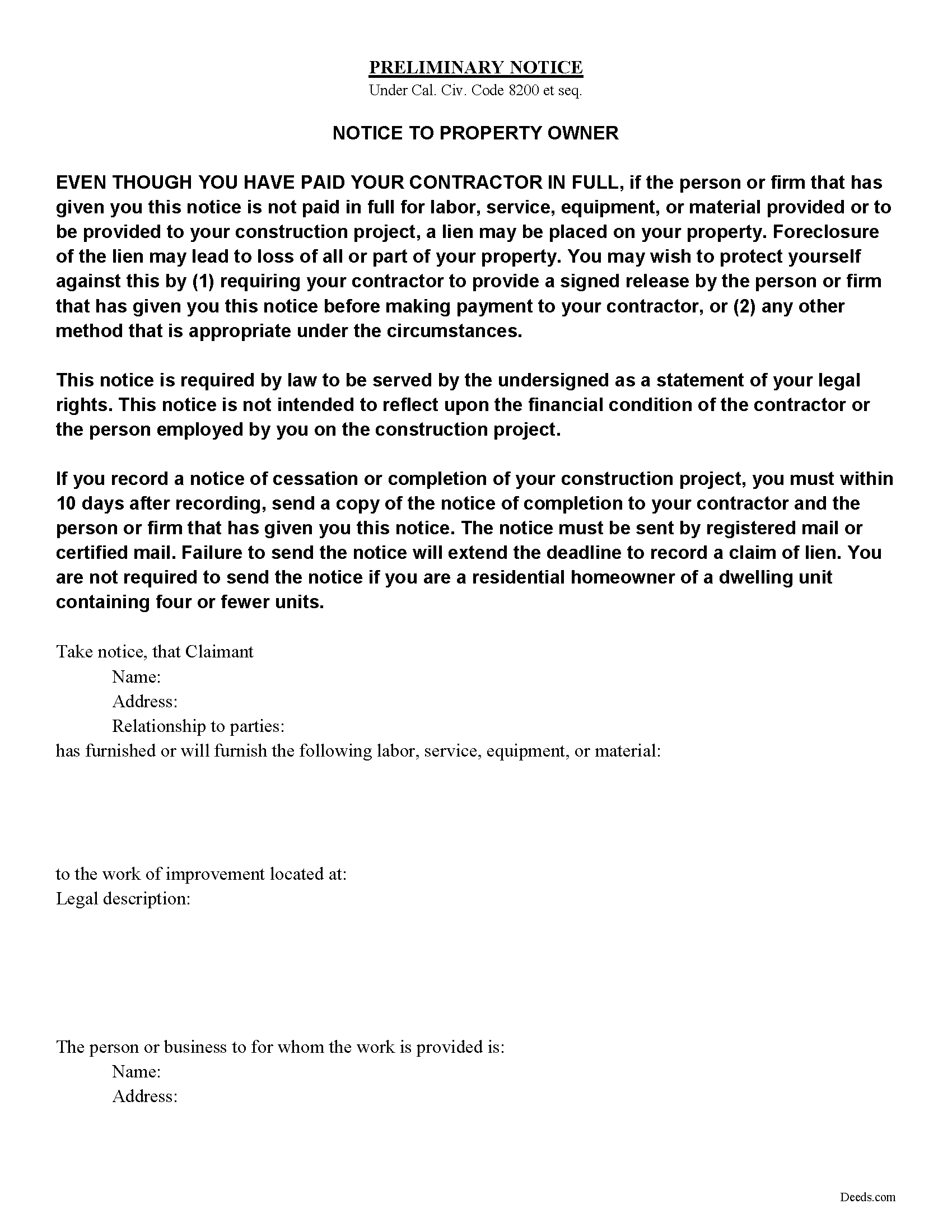
A claimant other than a laborer or direct contractor must serve preliminary notice under Civ. Code 8200 in order reserve the right to to claim a future mechanic's lien on a property. The notice must be served to the owner, direct contractor, and construction lender, if any.
California law requires notice to be served within 20 days of first furnishing labor, materials, services, or equipment in a work of improvement. A claimant may give late notice, but this limits the claimant's lien to only work performed within 20 days prior to giving the late notice, and work from that point forward (Civ. Code 8204).
Notices in relation to mechanic's liens must follow requirements under Civ. Code 8102, which include the names and addresses of the owners, direct contractor, and construction lender, if any, a description of the job site and job site address, and the name, address, and relationship to the parties of the claimant providing notice.
In addition to these requirements, the preliminary notice under Civ. Code 8200 requires a general description of the work provided by the potential claimant, an estimate of the total price of the work, and a verbatim notice to the property owner ... More Information about the California Preliminary Notice
Notice of Completion
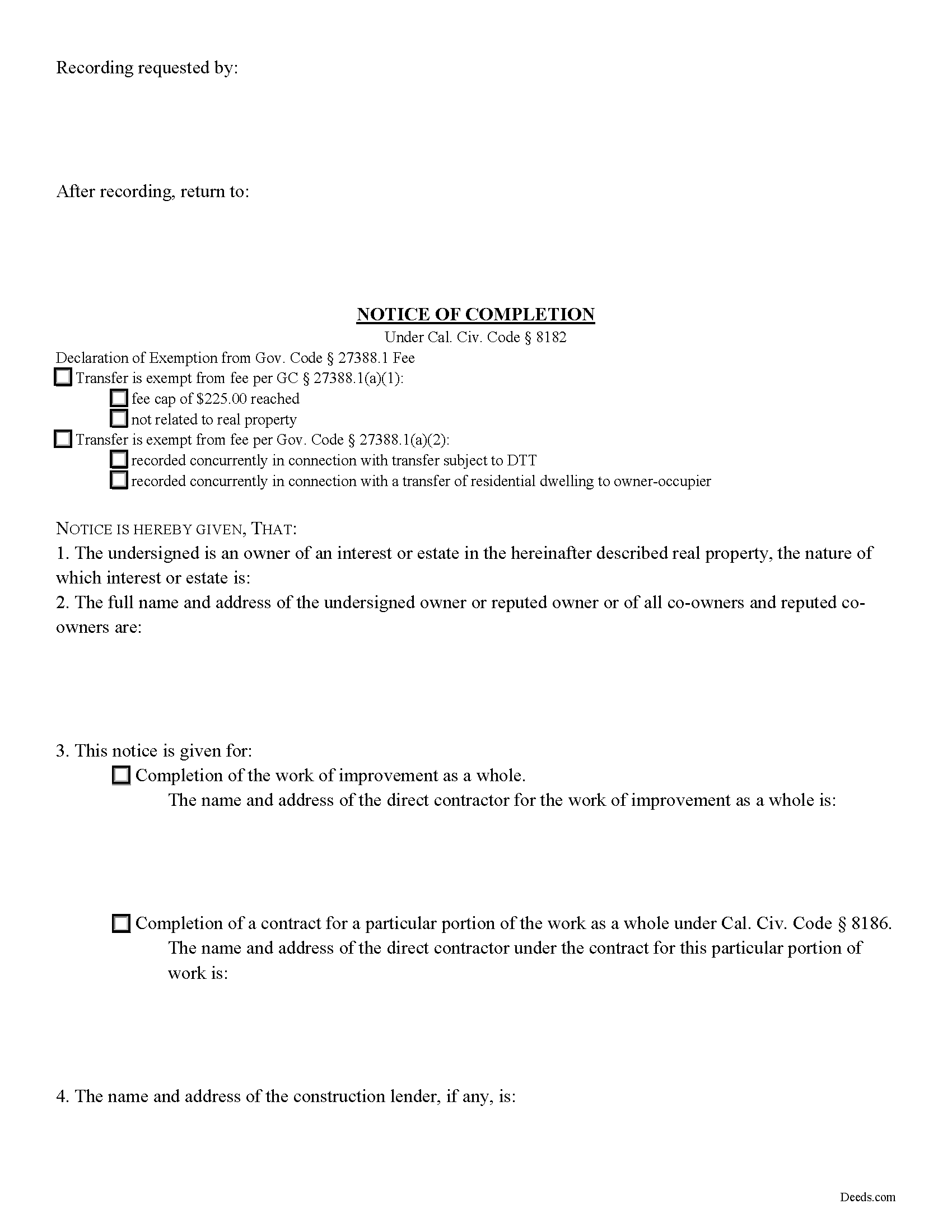
Under Cal. Civ. Code 8182, a real property owner can record a notice of completion at any time up to 15 days after the date of completion on a work of improvement. The notice of completion is an important document in the California mechanic's lien process, as it limits the time a claimant is allotted to file a claim of lien. A direct contractor has 60 days after the owner's filing of a notice of completion to file a claim of lien. If no notice of completion is filed within 15 days of completion of the project, the contractor has 90 days to file a claim of lien.
A lawful notice contains the name and address of each owner and the nature of the owner's interest or estate in the property, as well as the construction lender's name and address, if applicable. The notice gives the completion date and a general description of the work of improvement, as well as a legal description of the property on which the improvement is made, along with the property's address.
In California, a notice of completion may relate to the completion of a contract for work on an improvement as a whole or a contract for a portion of work. In either instance, the notice states the name and address of the ... More Information about the California Notice of Completion
Notice of Mechanics Lien
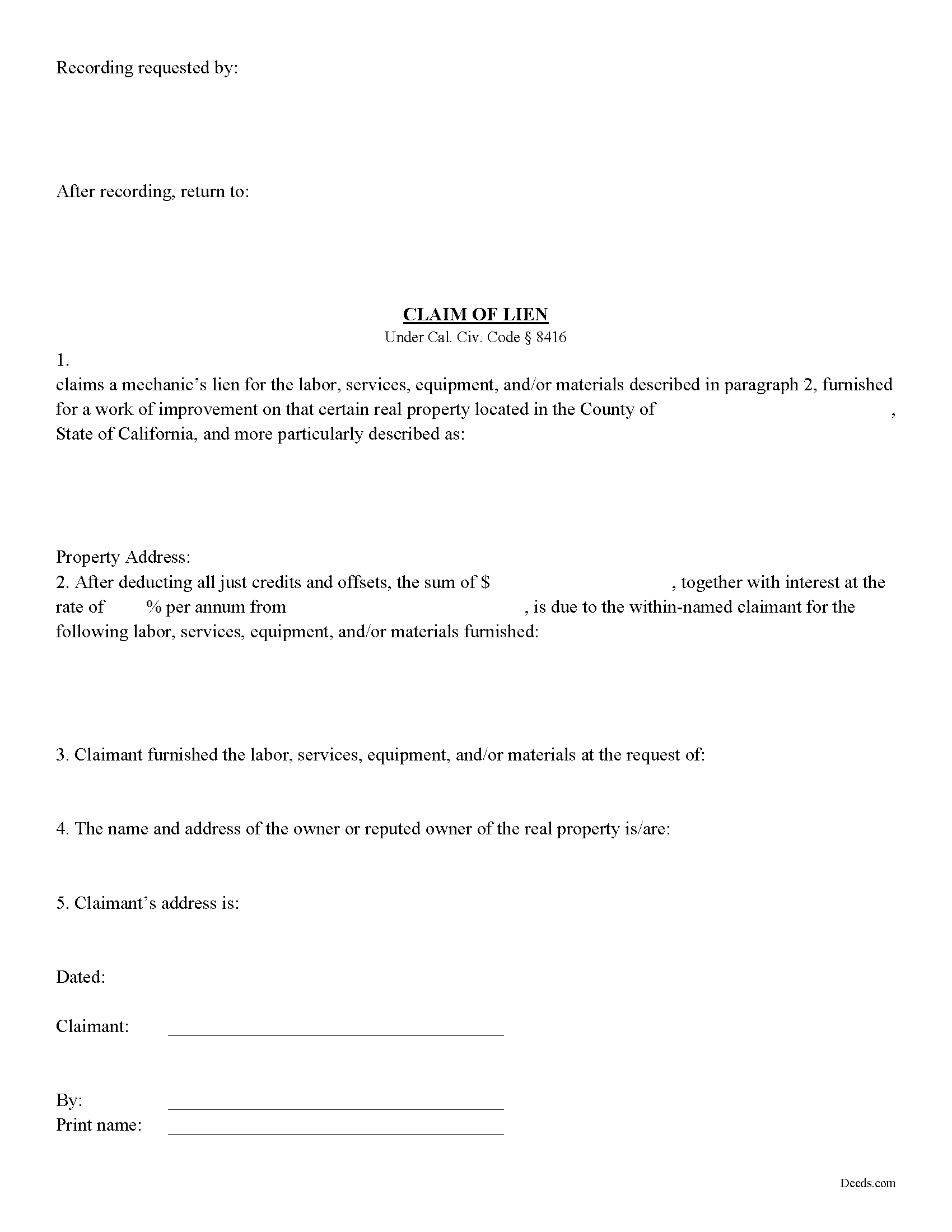
Mechanic's liens are an available remedy in the state of California for unpaid direct contractors, subcontractors, material suppliers, equipment lessors, laborers, design professionals, and any person providing work authorized for a site improvement (Civ. Code 8400).
To file a mechanic's lien in California, a claimant must have served preliminary notice to the property owner in accordance with Civ. Code 8410. In general, all work must have ceased before filing a claim of lien.
A direct contractor cannot enforce a lien unless a claim of lien is filed within 90 days after completion of work, or within 60 days after the owner records a notice of completion (Civ. Code 8412). A claimant other than a direct contractor may not enforce a lien unless the claimant records a claim of lien after it has ceased to provide work, or before the earlier of the following times: Ninety days after completion of the work of improvement, or thirty days after the owner records a notice of completion or cessation (Civ. Code 8414).
The law requires strict compliance with the statute in drafting and serving a mechanic's lien since it is an impediment on the owner's title that can affect his or her ... More Information about the California Notice of Mechanics Lien
Mineral Deed
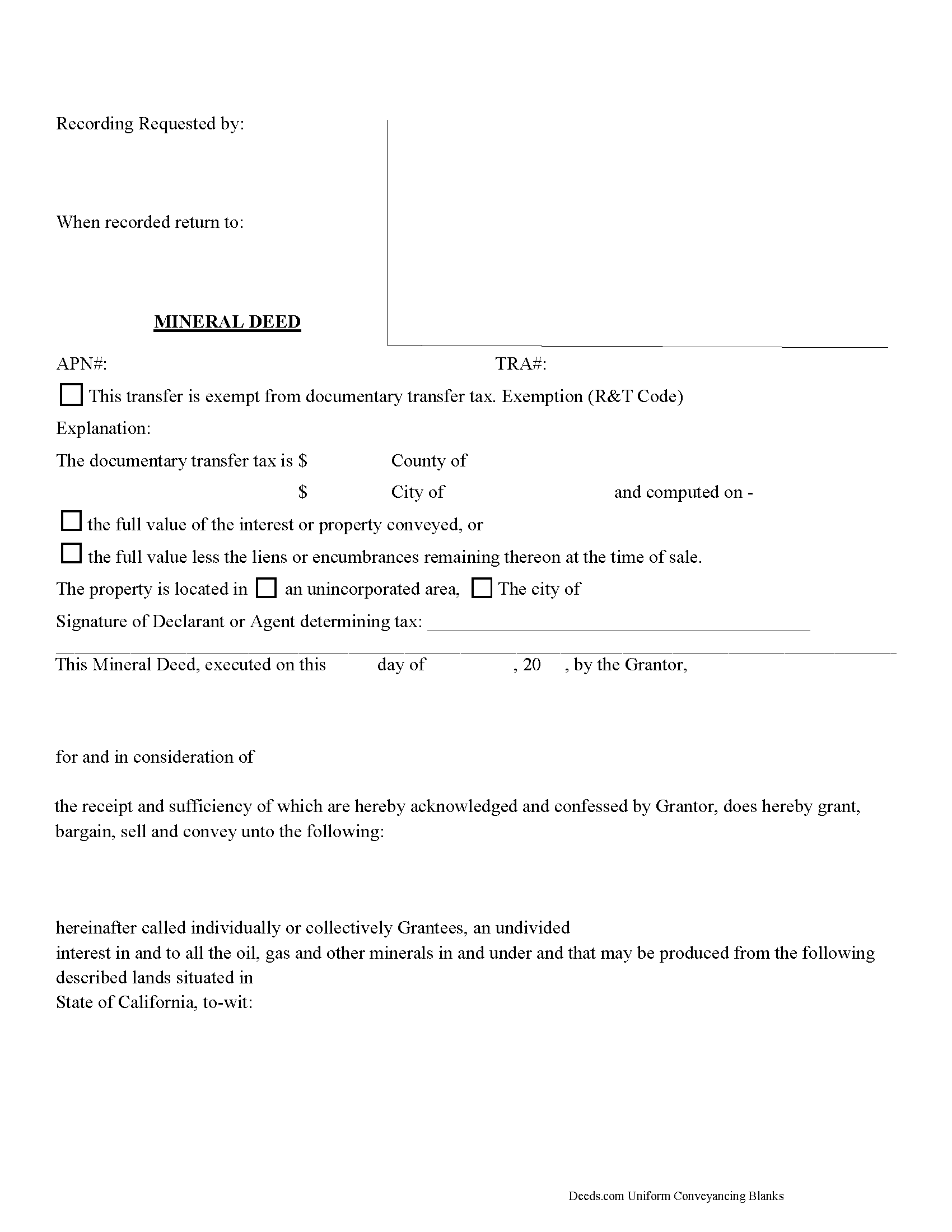
The General Mineral Deed in California transfers oil, gas, and mineral rights from the grantor to the grantee. THIS IS NOT A LEASE. There are no Exceptions or Reservations included.
The transfer includes the oil, gas and other minerals of every kind and nature. It also transfers any and all rights to receive royalties, overriding royalties, net profits interests or other payments out of or with respect to those oil, gas and other minerals. The Grantor can stipulate the percentage of Mineral Rights the Grantee will receive and is made subject to any rights existing under any valid and subsisting oil and gas lease or leases of record.
This general mineral deed gives the grantee the right to access, for the purpose of mining, drilling, exploring, operating and developing said lands for oil, gas, and other minerals, and storing handling, transporting and marketing of such.
In this document the Grantor Warrants and will defend said Title to Grantee. Use of this document has a permanent effect on your rights to the property, if you are not completely sure of what you are executing seek the advice of a legal professional.
(California Mineral Deed Package includes form, guideli... More Information about the California Mineral Deed
Mineral Deed with Quitclaim Covenants
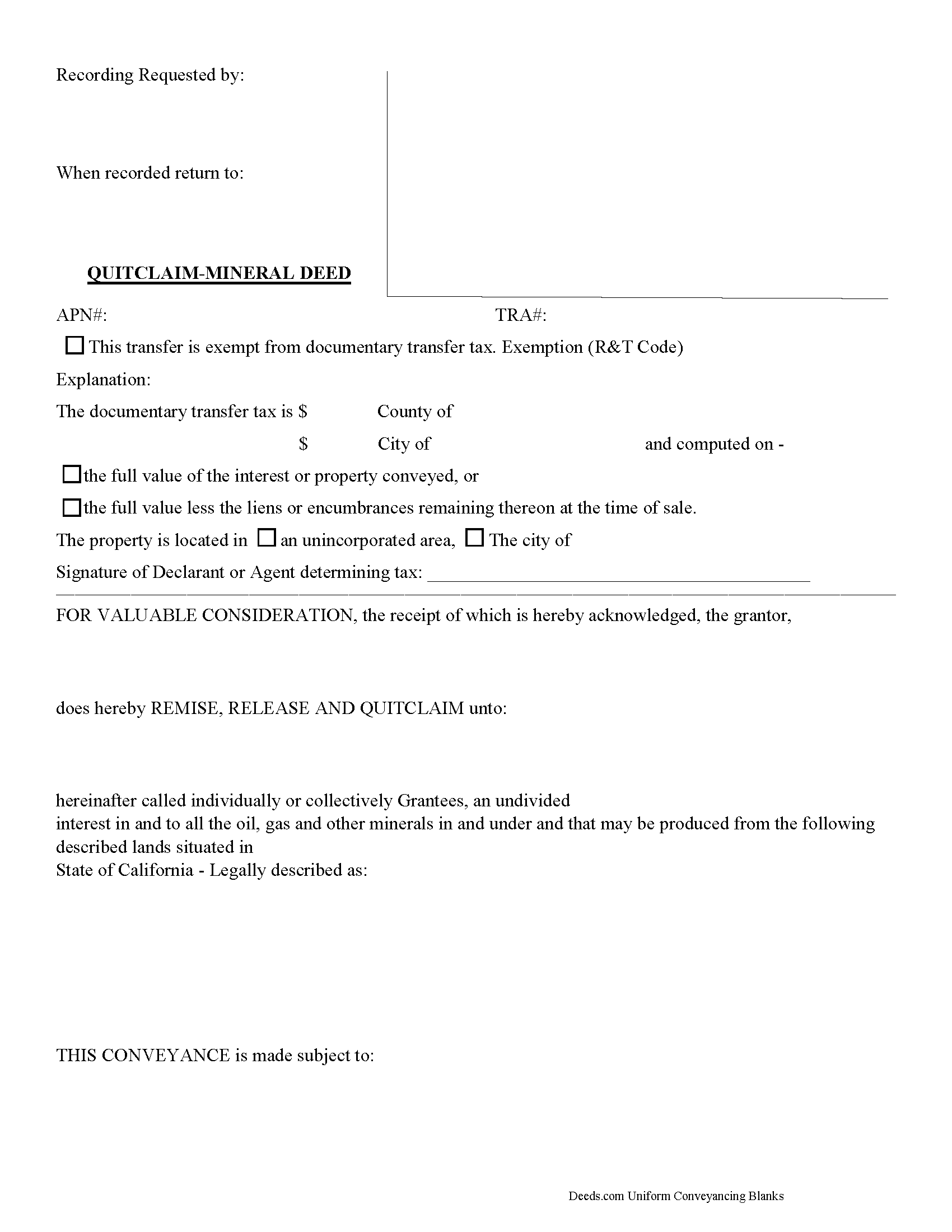
In California, a Mineral Quitclaim Deed (as per Civil Code Sections 1092, 1104-1107, 1113; Government Code Sections 27279-27297.7, 27320-27337) is used for transferring oil, gas, and mineral rights from the grantor to the grantee. It is a transfer of ownership, NOT A LEASE, and does not include exceptions or reservations.
Transfer Details: The deed transfers all kinds of mineral rights, including oil and gas. The grantor has the discretion to specify the percentage of mineral rights the grantee will receive.
Rights Conferred: This deed gives the grantee rights to access the land for mining, drilling, exploration, operation, development, storage, handling, transportation, and marketing of these minerals.
No Title Warranty: The grantor transfers mineral rights without any warranty of title, either express or implied, meaning the grantee accepts the title as it is, with all its potential discrepancies.
Uses: Mineral deeds with quitclaim are often used in situations where the grantor wants to quickly release any interest they might have in mineral rights, such as in settling estates, resolving disputes, clearing up uncertainties about ownership in a title's history or when ... More Information about the California Mineral Deed with Quitclaim Covenants
Notice of Pending Action
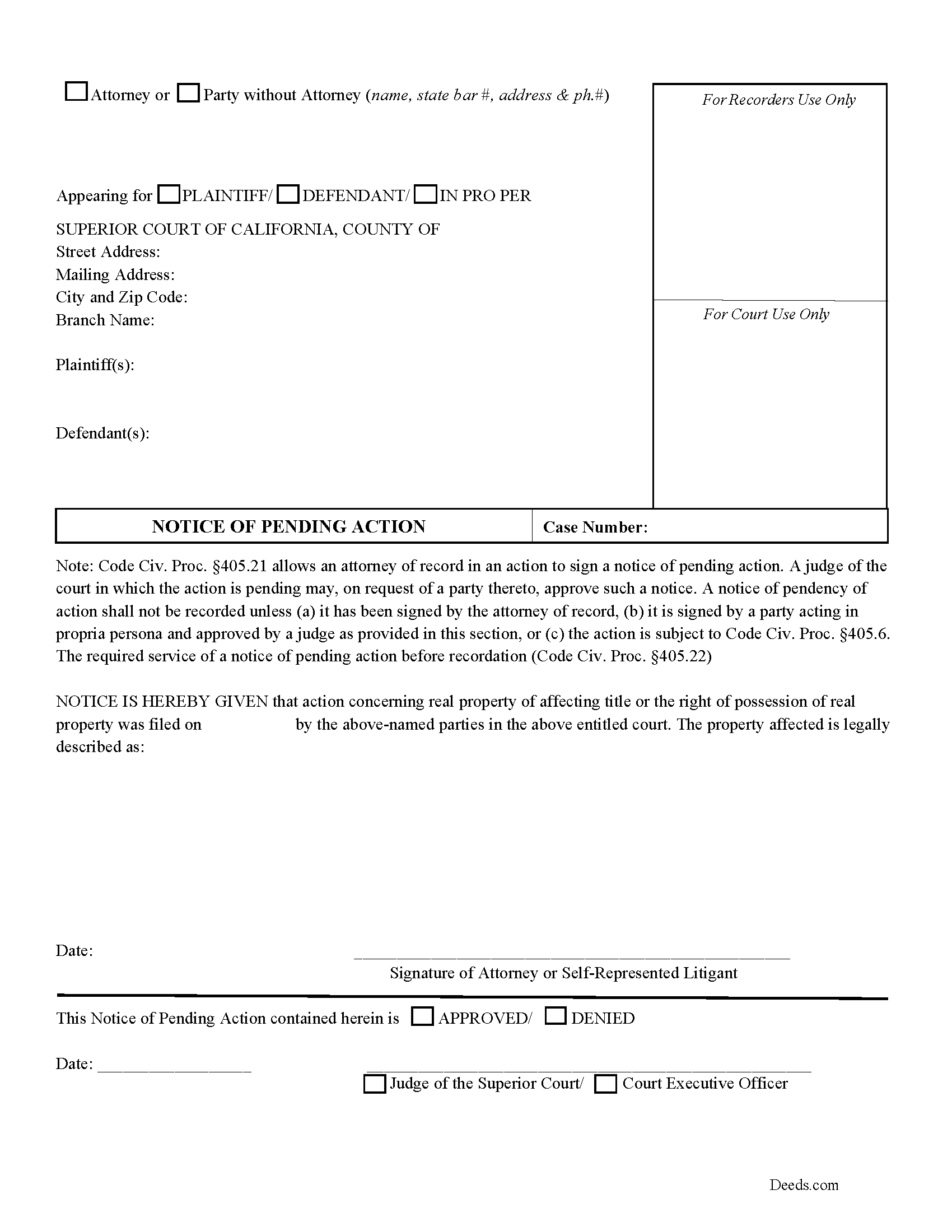
A Notice of Pending Action, formerly known as a lis pendens, is a document that is recorded to give constructive record notice of a pending lawsuit. The lawsuit must involve a claim which affects (a) title to, or right to possession of, real property; or (b) the use of an easement. [Code Civ. Proc. 405.4] When recorded, the notice lets subsequent buyers, transferees and encumbrancers know that an action is pending which affects the real property.
An attorney of record in an action may sign a notice of pendency of action. Alternatively, a judge of the court in which an action that includes a real property claim is pending may, on request of a party, approve a notice of pendency of action. A notice of pendency of action may only be recorded if: (1) it has been signed by the attorney of record; (2) it is signed by a party acting in propria persona ("for one's self," acting on one's own behalf) and approved by a judge; or (3) the action is one in eminent domain and subject to Code Civ. Proc. 405.6. [Code Civ. Proc. 405.21]
A party to an action who asserts a real property claim may record a notice of pendency in the action in which that real property claim is alleged. The notice ... More Information about the California Notice of Pending Action
Release of Notice of Pending Action
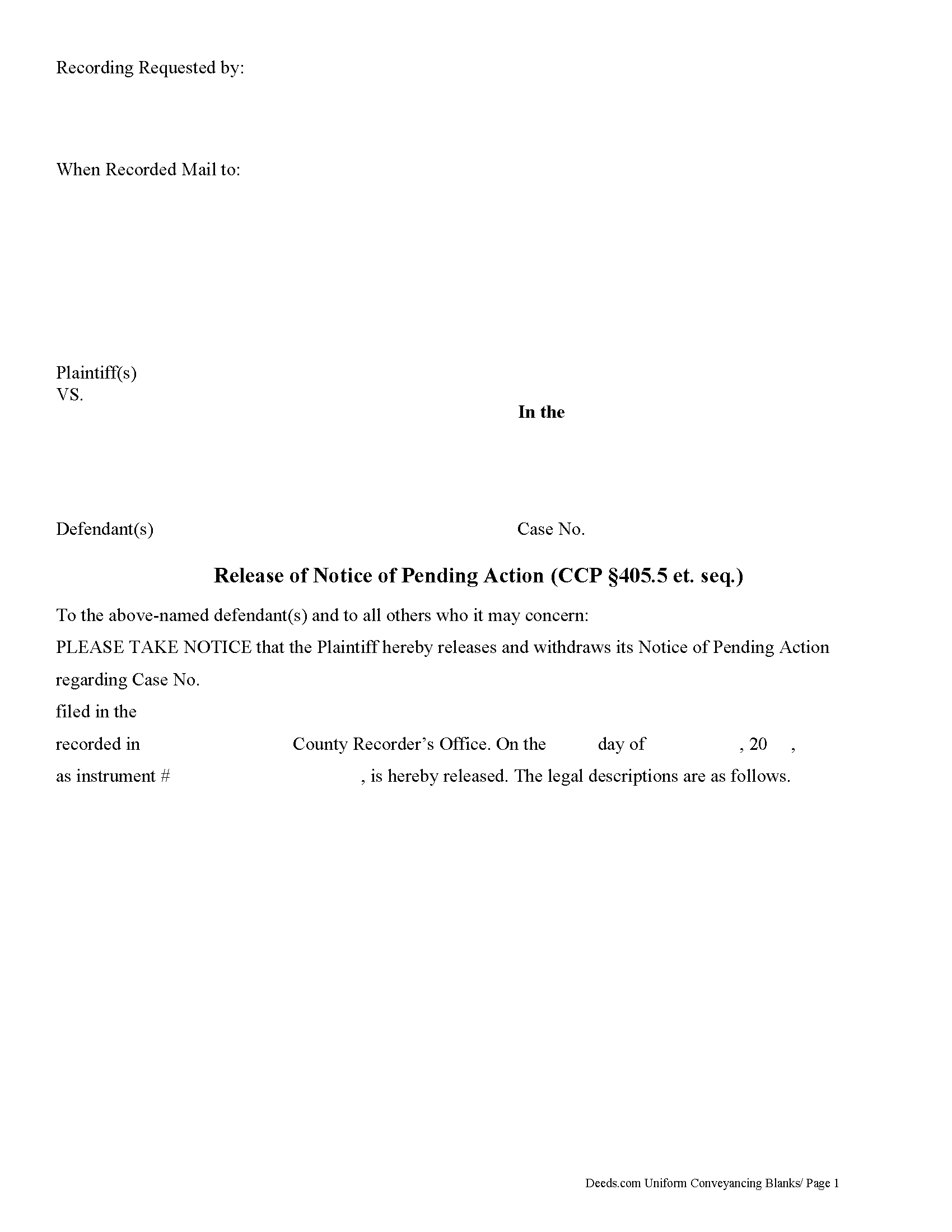
In California, the document notifying a property owner and the public about a pending lawsuit regarding that property, is called a Notice of Pending Action. The statutes primarily governing the recording of a notice of pendency of action are found at Code Civil Procedure, sections 405--405.61.
What happens, though, when the case is resolved? At that point, the plaintiff (individual who filed the suit) files a release. This action serves as notice of the resolution and clears the title. The Release of Notice of Pending Action in California is governed by the provisions of Code of Civ. Proc. section 405.50.
The release form identifies the parties and the property. It includes references to the pending lawsuit and the relevant dates. Before recording, the release form must be signed, in the presence of a notary public or other authorized official, by the party that recorded the original notice of pending action, or their successor in interest. Submit the release to the office of the recorder for the county in which the original lis pendens was recorded.
Lawsuits can be complicated, and even small errors can affect the outcome of a case. Please contact an attorney with ques... More Information about the California Release of Notice of Pending Action
Certificate of Trust
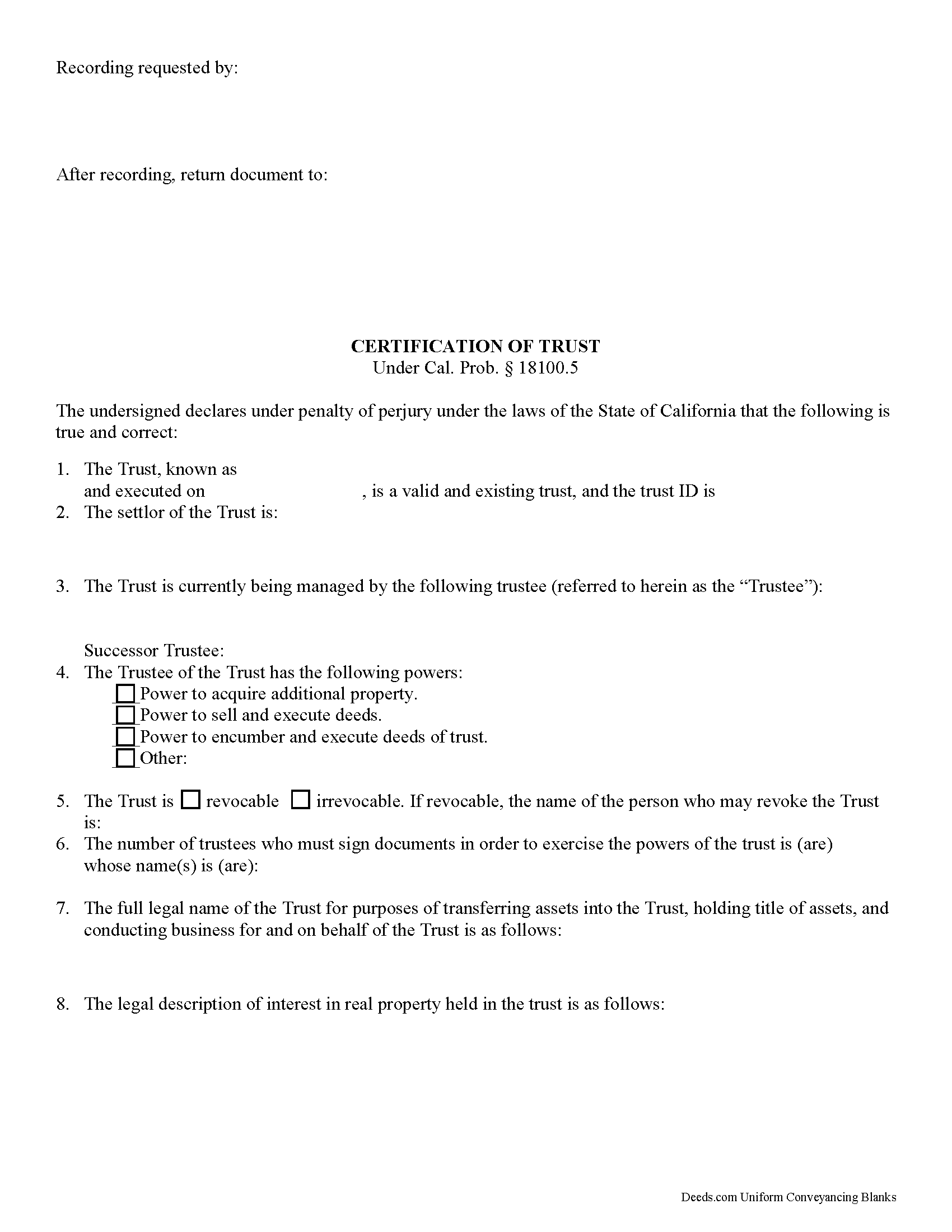
California Certification of Trust
In California, the certification of trust is governed by Probate Code Section 18100.5.
A certificate of trust is used by an acting trustee or trustees of a trust to prove to financial institutions or other third parties that he/she/they has/have the authority to act on behalf of the trust. The certificate is used in lieu of the full trust document to keep nonessential information about the trust, such as the identities of trust beneficiaries, confidential.
The certificate verifies the existence of the trust and presents the pertinent details of the trust, such as the settlor, the trustee, the powers granted to the trustee, and, in the case that there are co-trustees, the number and identity of persons required to sign legal documents dealing with the trust. The certificate also specifies how the trust will vest title to real property.
Like all documents affecting real estate, the certification requires a legal description of the real property subject to the trust. In California, the certification also must include the trust's taxpayer ID, a number that is either the SSN of the settlor (in the case of revocable trusts) or an EIN assigned b... More Information about the California Certificate of Trust
Trustee Deed
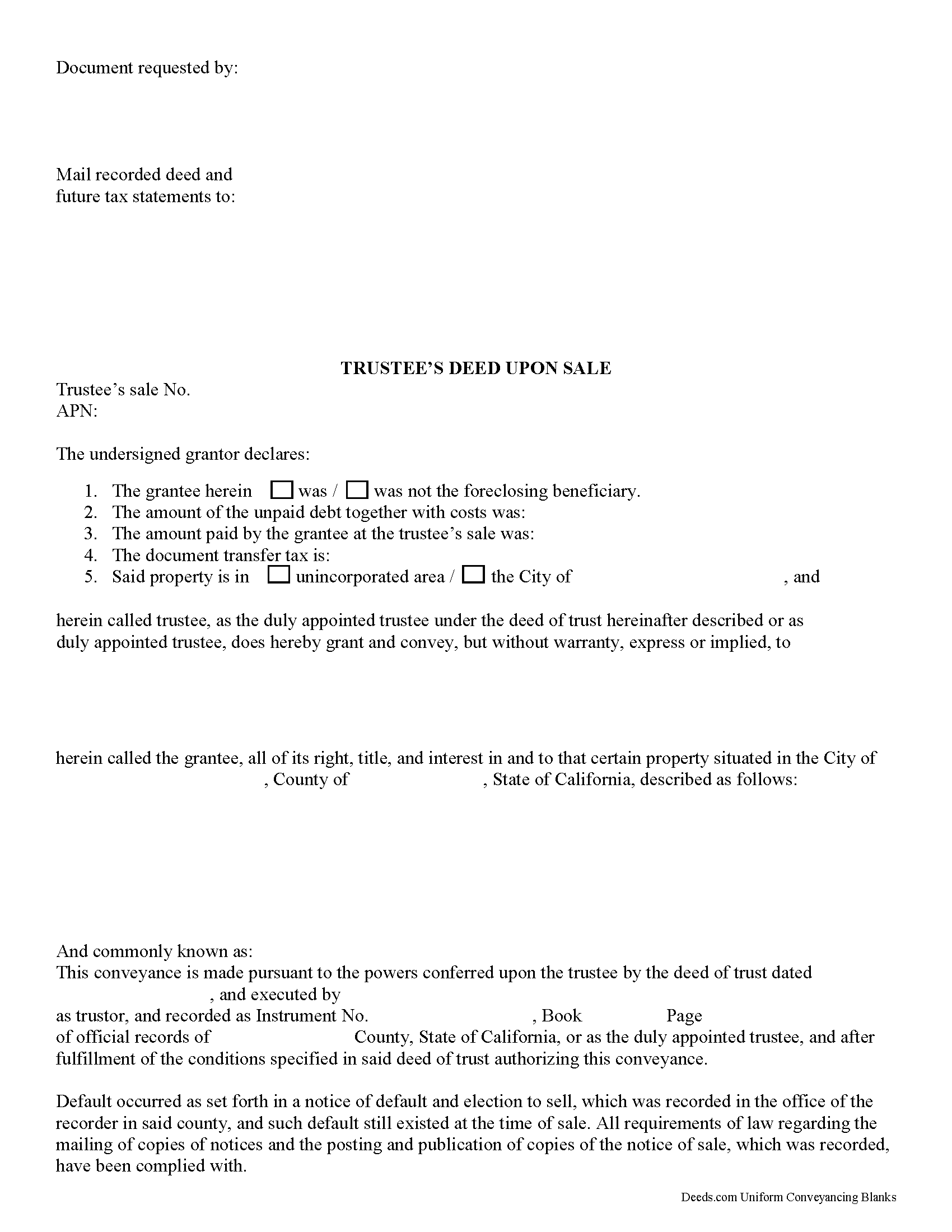
In California, a deed of trust is used as a mortgage alternative to secure a loan for real property. The borrower is the trustor of a deed of trust, and a trustee (usually an agent of the lending institution) is named as grantee, with the lending institution (secured lender) as the beneficiary (Cal. Civ. Code 2929.5(e)(1),(5)). The trustee's duty is to either reconvey the title upon satisfaction of the loan, or to initiate foreclosure as directed by the beneficiary.
Under the terms of the deed of trust, the beneficiary can initiate a non-judicial foreclosure if the trustor defaults on the loan or fails to satisfy the terms of the trust. The trustee is obligated to carry out certain steps before the foreclosure sale can take place. These processes, as well as mandates for the sale, are governed by Cal. Civ. Code 2924-2924h. Once the sale ends, the highest bidder receives a trustee's deed confirming the transfer of title. The trustee's deed is named for the trustee, who executes the deed and acts as the grantor.
The trustee's deed confirms the information from the deed of trust, including the trustor name (the borrower), the trustee, and the beneficiary (lender) under the dee... More Information about the California Trustee Deed